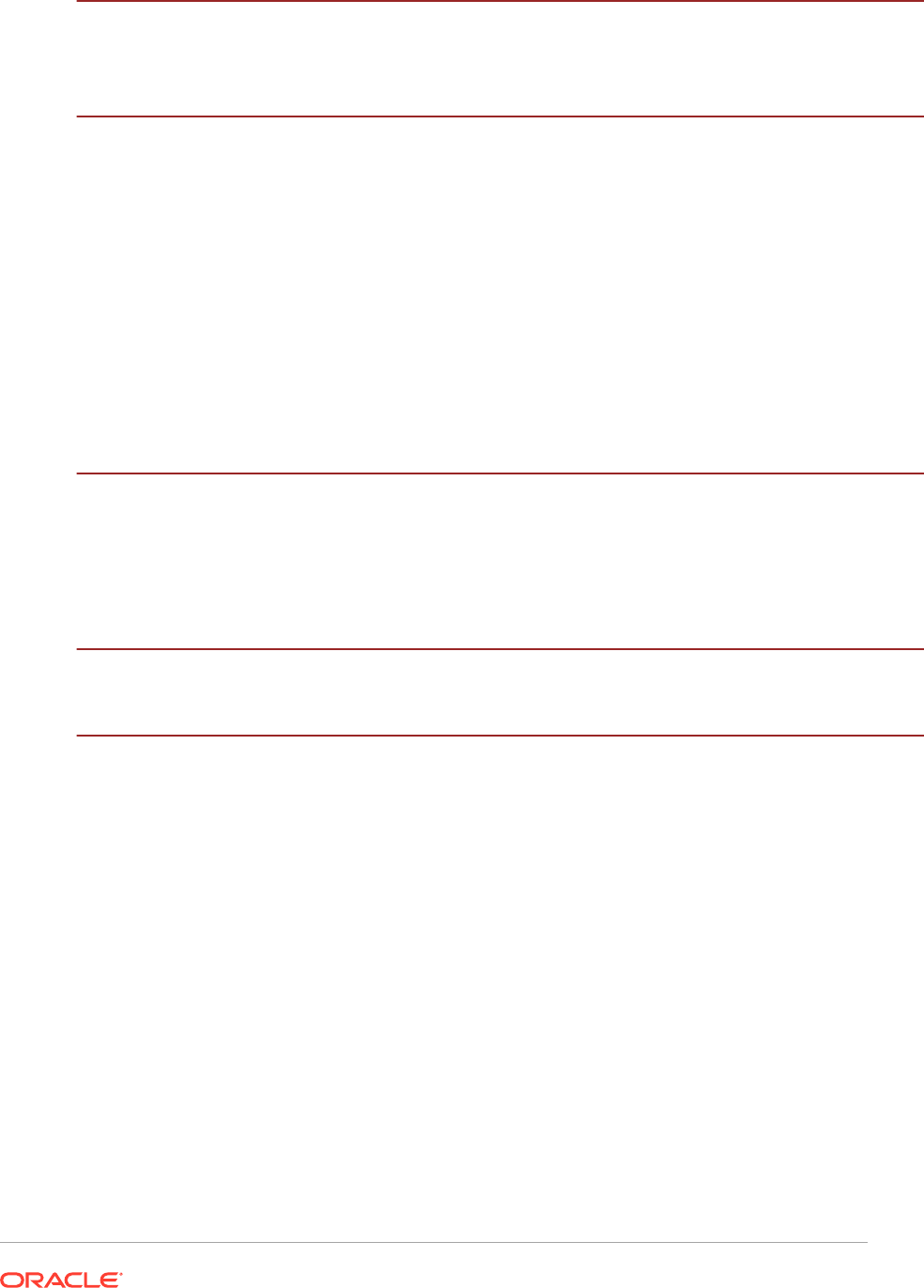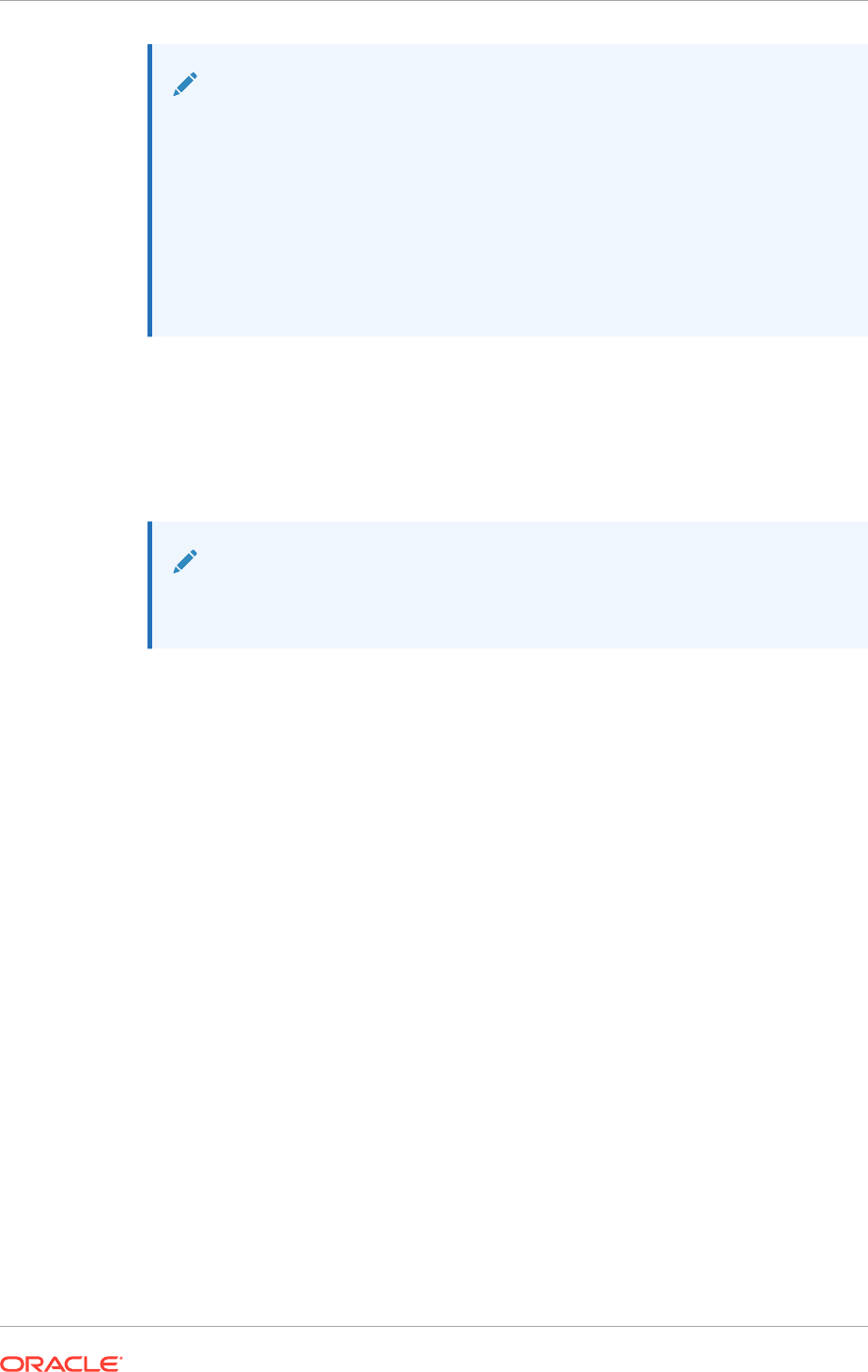
Java Platform, Standard Edition
Java Language Updates
Release 22
F87198-01
March 2024
Java Platform, Standard Edition Java Language Updates, Release 22
F87198-01
Copyright © 2017, 2024, Oracle and/or its affiliates.
This software and related documentation are provided under a license agreement containing restrictions on
use and disclosure and are protected by intellectual property laws. Except as expressly permitted in your
license agreement or allowed by law, you may not use, copy, reproduce, translate, broadcast, modify, license,
transmit, distribute, exhibit, perform, publish, or display any part, in any form, or by any means. Reverse
engineering, disassembly, or decompilation of this software, unless required by law for interoperability, is
prohibited.
The information contained herein is subject to change without notice and is not warranted to be error-free. If
you find any errors, please report them to us in writing.
If this is software, software documentation, data (as defined in the Federal Acquisition Regulation), or related
documentation that is delivered to the U.S. Government or anyone licensing it on behalf of the U.S.
Government, then the following notice is applicable:
U.S. GOVERNMENT END USERS: Oracle programs (including any operating system, integrated software,
any programs embedded, installed, or activated on delivered hardware, and modifications of such programs)
and Oracle computer documentation or other Oracle data delivered to or accessed by U.S. Government end
users are "commercial computer software," "commercial computer software documentation," or "limited rights
data" pursuant to the applicable Federal Acquisition Regulation and agency-specific supplemental
regulations. As such, the use, reproduction, duplication, release, display, disclosure, modification, preparation
of derivative works, and/or adaptation of i) Oracle programs (including any operating system, integrated
software, any programs embedded, installed, or activated on delivered hardware, and modifications of such
programs), ii) Oracle computer documentation and/or iii) other Oracle data, is subject to the rights and
limitations specified in the license contained in the applicable contract. The terms governing the U.S.
Government's use of Oracle cloud services are defined by the applicable contract for such services. No other
rights are granted to the U.S. Government.
This software or hardware is developed for general use in a variety of information management applications.
It is not developed or intended for use in any inherently dangerous applications, including applications that
may create a risk of personal injury. If you use this software or hardware in dangerous applications, then you
shall be responsible to take all appropriate fail-safe, backup, redundancy, and other measures to ensure its
safe use. Oracle Corporation and its affiliates disclaim any liability for any damages caused by use of this
software or hardware in dangerous applications.
Oracle®, Java, MySQL, and NetSuite are registered trademarks of Oracle and/or its affiliates. Other names
may be trademarks of their respective owners.
Intel and Intel Inside are trademarks or registered trademarks of Intel Corporation. All SPARC trademarks are
used under license and are trademarks or registered trademarks of SPARC International, Inc. AMD, Epyc,
and the AMD logo are trademarks or registered trademarks of Advanced Micro Devices. UNIX is a registered
trademark of The Open Group.
This software or hardware and documentation may provide access to or information about content, products,
and services from third parties. Oracle Corporation and its affiliates are not responsible for and expressly
disclaim all warranties of any kind with respect to third-party content, products, and services unless otherwise
set forth in an applicable agreement between you and Oracle. Oracle Corporation and its affiliates will not be
responsible for any loss, costs, or damages incurred due to your access to or use of third-party content,
products, or services, except as set forth in an applicable agreement between you and Oracle.
For information about Oracle's commitment to accessibility, visit the Oracle Accessibility Program website at
http://www.oracle.com/pls/topic/lookup?ctx=acc&id=docacc
.

Contents
Preface
Audience vi
Documentation Accessibility vi
Diversity and Inclusion vi
Related Documents vi
Conventions vi
1
Java Language Changes
Java Language Changes for Java SE 22 1-1
Java Language Changes for Java SE 21 1-2
Java Language Changes for Java SE 20 1-3
Java Language Changes for Java SE 19 1-4
Java Language Changes for Java SE 18 1-5
Java Language Changes for Java SE 17 1-6
Java Language Changes for Java SE 16 1-7
Java Language Changes for Java SE 15 1-8
Java Language Changes for Java SE 14 1-8
Java Language Changes for Java SE 13 1-9
Java Language Changes for Java SE 12 1-9
Java Language Changes for Java SE 11 1-10
Java Language Changes for Java SE 10 1-10
Java Language Changes for Java SE 9 1-10
More Concise try-with-resources Statements 1-11
@SafeVarargs Annotation Allowed on Private Instance Methods 1-12
Diamond Syntax and Anonymous Inner Classes 1-12
Underscore Character Not Legal Name 1-12
Support for Private Interface Methods 1-12
2
Preview Features
iii

3
Statements Before super(…)
The Preconstruction Context of a Constructor 3-1
4
String Templates
Basic Usage of String Templates 4-1
Embedded Expressions in String Templates 4-2
Multiline String Templates 4-4
The FMT Template Processor 4-5
The RAW Template Processor 4-6
Creating a Template Processor 4-7
Creating a Template Processor that Returns JSON Objects 4-7
Creating a Template Processor that Safely Composes and Runs Database Queries 4-10
Creating a Template Processor that Simplifies the Use of Resource Bundles 4-12
5
Implicitly Declared Classes and Instance Main Methods
Flexible Launch Protocol 5-3
Implicitly Declared Classes 5-3
Growing a Program 5-5
6
Sealed Classes
7
Pattern Matching
Pattern Matching for the instanceof Operator 7-1
Scope of Pattern Variables 7-3
Pattern Matching for switch Expressions and Statements 7-4
Selector Expression Type 7-5
When Clauses 7-5
Qualified enum Constants as case Constants 7-6
Pattern Label Dominance 7-8
Type Coverage in switch Expressions and Statements 7-9
Inference of Type Arguments in Record Patterns 7-12
Scope of Pattern Variable Declarations 7-13
Null case Labels 7-15
Record Patterns 7-16
iv

Preface
This guide describes the updated language features in Java SE 9 and subsequent
releases.
Audience
This document is for Java developers.
Documentation Accessibility
For information about Oracle's commitment to accessibility, visit the Oracle
Accessibility Program website at http://www.oracle.com/pls/topic/lookup?
ctx=acc&id=docacc.
Access to Oracle Support
Oracle customers that have purchased support have access to electronic support
through My Oracle Support. For information, visit http://www.oracle.com/pls/topic/
lookup?ctx=acc&id=info or visit http://www.oracle.com/pls/topic/lookup?ctx=acc&id=trs
if you are hearing impaired.
Diversity and Inclusion
Oracle is fully committed to diversity and inclusion. Oracle respects and values having
a diverse workforce that increases thought leadership and innovation. As part of our
initiative to build a more inclusive culture that positively impacts our employees,
customers, and partners, we are working to remove insensitive terms from our
products and documentation. We are also mindful of the necessity to maintain
compatibility with our customers' existing technologies and the need to ensure
continuity of service as Oracle's offerings and industry standards evolve. Because of
these technical constraints, our effort to remove insensitive terms is ongoing and will
take time and external cooperation.
Related Documents
See JDK 22 Documentation.
Conventions
The following text conventions are used in this document:
Preface
vi

Convention Meaning
boldface
Boldface type indicates graphical user interface elements associated with an
action, or terms defined in text or the glossary.
italic Italic type indicates book titles, emphasis, or placeholder variables for which
you supply particular values.
monospace
Monospace type indicates commands within a paragraph, URLs, code in
examples, text that appears on the screen, or text that you enter.
Preface
vii

1
Java Language Changes
This section summarizes the updated language features in Java SE 9 and subsequent
releases.
Java Language Changes for Java SE 22
Feature Description JEP
Statements Before super(...) Introduced as a preview feature
for this release.
In constructors in the Java
programming language, you may
add statements that don't
reference the instance being
created before an explicit
constructor invocation.
JEP 447: Statements before
super(...) (Preview)
Unnamed Variables and Patterns First previewed in Java SE 21 as
Unnamed Patterns and
Variables, this feature is
permanent in this release. This
means that it can be used in any
program compiled for Java SE 22
without enabling preview
features.
This feature remains unchanged
since Java SE 21.
JEP 456: Unnamed Variables &
Patterns
String Templates Preview feature from Java SE 21
re-previewed for this release.
Except for a technical change in
the types of template
expressions, which is described
in String Templates (Second
Preview) in The Java Language
Specification: Java SE 22
Edition, this feature remains
unchanged since Java SE 21.
JEP 459: String Templates
(Second Preview)
1-1

Feature Description JEP
Implicitly Declared Classes and
Instance Main Methods
First previewed in Java SE 21 as
JEP 445: Unnamed Classes and
Instance Main Methods
(Preview), this feature is re-
previewed for this release as JEP
463: Implicitly Declared Classes
and Instance Main Methods
(Second Preview).
In this release:
• A source file without an
enclosing class declaration
is said to implicitly declare a
class with a name chosen by
the host system.
• The procedure for selecting
a
main
method is simplified.
If there is a candidate
main
method with a
String[]
parameter then we invoke
that method; otherwise we
invoke a candidate
main
method with no parameters.
JEP 463: Implicitly Declared
Classes and Instance Main
Methods (Second Preview)
Java Language Changes for Java SE 21
Feature Description JEP
Record Patterns First previewed in Java SE 19,
this feature is permanent in
this release. This means that it
can be used in any program
compiled for Java SE 21
without enabling preview
features.
In this release, support for
record patterns appearing in
the header of an enhanced
for
statement has been
removed.
JEP 440: Record Patterns
Pattern Matching for switch
Expressions and Statements
First previewed in Java SE 17,
this feature is permanent in
this release. This means that it
can be used in any program
compiled for Java SE 21
without enabling preview
features.
In this release:
• Parenthesized patterns
have been removed.
• Qualified
enum
constants
as
case
constants in
switch
expressions and
statements are allowed.
JEP 441: Pattern Matching for
switch
Chapter 1
Java Language Changes for Java SE 21
1-2

Feature Description JEP
String Templates Introduced as a preview
feature for this release.
String templates complement
Java's existing string literals
and text blocks by coupling
literal text with embedded
expressions and template
processors to produce
specialized results.
JEP 430: String Templates
(Preview)
Unnamed Patterns and
Variables
Introduced as a preview
feature for this release.
Unnamed patterns match a
record component without
stating the component's name
or type. Unnamed variables
are variables that can be
initialized but not used. You
denote both with the
underscore character (
_
).
JEP 443: Unnamed Patterns
and Variables (Preview)
Unnamed Classes and
Instance Main Methods
Introduced as a preview
feature for this release.
Unnamed classes and
instance main methods enable
students to write streamlined
declarations for single-class
programs and then seamlessly
expand their programs later to
use more advanced features
as their skills grow.
JEP 445: Unnamed Classes
and Instance Main Methods
(Preview)
Java Language Changes for Java SE 20
Chapter 1
Java Language Changes for Java SE 20
1-3

Feature Description JEP
Pattern Matching for switch
Expressions and Statements
Preview feature from Java SE
17 re-previewed for this
release.
In this release:
• An exhaustive switch (that
is, a
switch
expression
or a pattern
switch
statement) over an
enum
class throws a
MatchException
instead of an
IncompatibleClass
ChangeError if no
switch
label applies at
run time.
• The grammar for
switch
labels is simpler.
• The compiler can infer the
type of the type
arguments for generic
record patterns in all
constructs that accept
patterns:
switch
statements and
expressions,
instanceof
expressions, and
enhanced
for
statements.
JEP 433: Pattern Matching for
switch (Fourth Preview)
Record Patterns Preview feature from Java SE
19 re-previewed for this
release.
In this release:
• The compiler can infer the
type of the type
arguments for generic
record patterns.
• Record patterns can
appear in an enhanced
for
statement.
• Named record patterns
are no longer supported.
JEP 432: Record Patterns
(Second Preview)
Java Language Changes for Java SE 19
Chapter 1
Java Language Changes for Java SE 19
1-4

Feature Description JEP
Pattern Matching for switch
Expressions and Statements
Preview feature from Java SE 17
re-previewed for this release.
In this release:
• The syntax of a guarded
pattern label consists of a
pattern and a
when
clause.
• If a selector expression
evaluates to
null
and the
switch
block does not have
null
case label, then a
NullPointerException
is
thrown, even if a pattern
label can match the type of
the
null
value.
• If a
switch
expression or
statement is exhaustive at
compile time but not at run
time, then a
MatchException
is thrown.
JEP 427: Pattern Matching for
switch (Third Preview)
Record Patterns Introduced as a preview feature
for this release.
A record pattern consists of a
type, a record component pattern
list used to match against the
corresponding record
components, and an optional
identifier. You can nest record
patterns and type patterns to
enable a powerful, declarative,
and composable form of data
navigation and processing.
JEP 405: Record Patterns
(Preview)
Java Language Changes for Java SE 18
Chapter 1
Java Language Changes for Java SE 18
1-5

Feature Description JEP
Pattern Matching for switch
Expressions and Statements
Preview feature from Java SE
17 re-previewed for this
release.
In this release:
• Dominance checking
forces a constant label to
appear before a guarded
pattern labels, which must
appear before a non-
guarded type pattern
label; see the section
"Pattern Label
Dominance" in Pattern
Matching for switch
Expressions and
Statements.
• Exhaustiveness checking
has been expanded to
take into account generic
sealed classes and to
check
switch
expressions; see the
section "Type Coverage in
switch Expressions and
Statements" in Pattern
Matching for switch
Expressions and
Statements and the
section "Exhaustiveness
of switch Statements" in
Switch Expressions.
JEP 420: Pattern Matching for
switch (Second Preview)
Java Language Changes for Java SE 17
Feature Description JEP
Sealed Classes First previewed in Java SE 15,
this feature is permanent in
this release. This means that it
can be used in any program
compiled for Java SE 17
without enabling preview
features.
A sealed class or interface
restricts which classes or
interfaces can extend or
implement it.
JEP 409: Sealed Classes
Chapter 1
Java Language Changes for Java SE 17
1-6

Feature Description JEP
Pattern Matching for switch
Expressions and Statements
Introduced as a preview
feature for this release.
Pattern matching for
switch
expressions and statements
allows an expression to be
tested against a number of
patterns, each with a specific
action, so that complex data-
oriented queries can be
expressed concisely and
safely.
JEP 406: Pattern Matching for
switch (Preview)
Java Language Changes for Java SE 16
Feature Description JEP
Sealed Classes Preview feature from Java SE 15
re-previewed for this release. It
has been enhanced with several
refinements, including more strict
checking of narrowing reference
conversions with respect to
sealed type hierarchies.
A sealed class or interface
restricts which classes or
interfaces can extend or
implement it.
JEP 397: Sealed Classes
(Second Preview)
Record Classes First previewed in Java SE 14,
this feature is permanent in this
release. This means that it can
be used in any program compiled
for Java SE 16 without enabling
preview features.
In this release, inner classes may
declare members that are either
explicitly or implicitly static. This
includes record class members,
which are implicitly static.
A record is a class that acts as
transparent carrier for immutable
data.
JEP 395: Records
Chapter 1
Java Language Changes for Java SE 16
1-7

Feature Description JEP
Pattern Matching for instanceof First previewed in Java SE 14,
this feature is permanent in this
release. This means that it can
be used in any program compiled
for Java SE 16 without enabling
preview features.
In this release, pattern variables
are no longer implicitly final, and
it's a compile-time error if a
pattern
instanceof
expression
compares an expression of type
S
with a pattern of type
T
, where
S
is a subtype of
T
.
Pattern matching allows common
logic in a program, namely the
conditional extraction of
components from objects, to be
expressed more concisely and
safely.
JEP 394: Pattern Matching for
instanceof
Java Language Changes for Java SE 15
Feature Description JEP
Sealed Classes Introduced as a preview feature for this release.
A sealed class or interface restricts which classes or
interfaces can extend or implement it.
JEP 360: Sealed Classes
(Preview)
Record Classes Preview feature from Java SE 14 re-previewed for this
release. It has been enhanced with support for local
records.
A record is a class that acts as transparent carrier for
immutable data.
JEP 384: Records (Second
Preview)
Pattern Matching for
instanceof
Preview feature from Java SE 14 re-previewed for this
release. It is unchanged between Java SE 14 and this
release.
Pattern matching allows common logic in a program,
namely the conditional extraction of components from
objects, to be expressed more concisely and safely.
JEP 375: Pattern Matching
for instanceof (Second
Preview)
Text Blocks
See also Programmer's
Guide to Text Blocks
First previewed in Java SE 13, this feature is permanent
in this release. This means that it can be used in any
program compiled for Java SE 15 without enabling
preview features.
A text block is a multiline string literal that avoids the
need for most escape sequences, automatically formats
the string in a predictable way, and gives the developer
control over the format when desired.
JEP 378: Text Blocks
Java Language Changes for Java SE 14
Chapter 1
Java Language Changes for Java SE 15
1-8

Feature Description JEP
Pattern Matching for the
instanceof Operator
Introduced as a preview feature for this release.
Pattern matching allows common logic in a program,
namely the conditional extraction of components from
objects, to be expressed more concisely and safely.
JEP 305: Pattern Matching
for instanceof
(Preview)JEP 305: Pattern
Matching for instanceof
(Preview)
Records Introduced as a preview feature for this release.
Records provide a compact syntax for declaring classes
which are transparent holders for shallowly immutable
data.
JEP 359: Records
(Preview)
Text Blocks
See also Programmer's
Guide to Text Blocks
Preview feature from Java SE 13 re-previewed for this
release. It has been enhanced with support for more
escape sequences.
A text block is a multiline string literal that avoids the
need for most escape sequences, automatically formats
the string in a predictable way, and gives the developer
control over the format when desired.
JEP 375: Pattern Matching
for instanceof (Second
Preview)
Switch Expressions First previewed in Java SE 12, this feature is permanent
in this release. This means that it can be used in any
program compiled for Java SE 14 without needing to
enable preview features.
This feature extends
switch
so it can be used as either
a statement or an expression, and so that both forms
can use either traditional
case ... :
labels (with fall
through) or new
case ... ->
labels (with no fall
through), with a further new statement for yielding a
value from a
switch
expression.
JEP 361: Switch
Expressions (Standard)
Java Language Changes for Java SE 13
Feature Description JEP
Text Blocks, see
Programmer's Guide to
Text Blocks
Introduced as a preview feature for this release.
A text block is a multi-line string literal that avoids the
need for most escape sequences, automatically formats
the string in a predictable way, and gives the developer
control over format when desired.
JEP 355: Text Blocks
(Preview)
Switch Expressions Preview feature from Java SE 12 re-previewed for this
release. It has been enhanced with one change: To
specify the value of a
switch
expression, use the new
yield
statement instead of the
break
statement.
This feature extends
switch
so it can be used as either
a statement or an expression, and so that both forms
can use either traditional
case ... :
labels (with fall
through) or new
case ... ->
labels (with no fall
through), with a further new statement for yielding a
value from a
switch
expression. .
JEP 354: Switch
Expressions (Second
Preview)
Java Language Changes for Java SE 12
Chapter 1
Java Language Changes for Java SE 13
1-9

Feature Description JEP
Switch Expressions Introduced as a preview feature for this release.
This feature extends the
switch
statement so that it can
be used as either a statement or an expression, and that
both forms can use either a "traditional" or "simplified"
scoping and control flow behavior.
JEP 325: Switch
Expressions (Preview)
Java Language Changes for Java SE 11
Feature Description JEP
Local Variable Type
Inference
See also Local Variable
Type Inference: Style
Guidelines
Introduced in Java SE 10. In this release, it has been
enhanced with support for allowing
var
to be used when
declaring the formal parameters of implicitly typed
lambda expressions.
Local-Variable Type Inference extends type inference to
declarations of local variables with initializers.
• JEP 286: Local-
Variable Type
Inference
• JEP 323: Local-
Variable Syntax for
Lambda Parameters
Java Language Changes for Java SE 10
Feature Description JEP
Local Variable Type
Inference
See also Local Variable
Type Inference: Style
Guidelines
Introduced in this release.
Local-Variable Type Inference extends type inference to
declarations of local variables with initializers.
JEP 286: Local-Variable
Type Inference
Java Language Changes for Java SE 9
Feature Description JEP
Java Platform module
system, see Project
Jigsaw on OpenJDK.
Introduced in this release.
The Java Platform module system introduces a
new kind of Java programing component, the
module, which is a named, self-describing
collection of code and data. Its code is
organized as a set of packages containing
types, that is, Java classes and interfaces; its
data includes resources and other kinds of
static information. Modules can either export
or encapsulate packages, and they express
dependencies on other modules explicitly.
Java Platform Module
System (JSR 376)
• JEP 261: Module
System
• JEP 200: The
Modular JDK
• JEP 220: Modular
Run-Time Images
• JEP 260:
Encapsulate Most
Internal APIs
Chapter 1
Java Language Changes for Java SE 11
1-10

Feature Description JEP
Small language
enhancements
(Project Coin):
• More Concise try-
with-resources
Statements
• @SafeVarargs
Annotation
Allowed on
Private Instance
Methods
• Diamond Syntax
and Anonymous
Inner Classes
• Underscore
Character Not
Legal Name
• Support for
Private Interface
Methods
Introduced in Java SE 7 as Project Coin. It has
been enhanced with a few amendments.
JEP 213: Milling
Project Coin
JSR 334: Small
Enhancements to the
Java Programming
Language
More Concise try-with-resources Statements
If you already have a resource as a
final
or effectively
final
variable, you can use that
variable in a
try-with-resources
statement without declaring a new variable. An "effectively
final" variable is one whose value is never changed after it is initialized.
For example, you declared these two resources:
// A final resource
final Resource resource1 = new Resource("resource1");
// An effectively final resource
Resource resource2 = new Resource("resource2");
In Java SE 7 or 8, you would declare new variables, like this:
try (Resource r1 = resource1;
Resource r2 = resource2) {
...
}
In Java SE 9, you don’t need to declare
r1
and
r2
:
// New and improved try-with-resources statement in Java SE 9
try (resource1;
resource2) {
...
}
There is a more complete description of the try-with-resources statement in The Java
Tutorials (Java SE 8 and earlier).
Chapter 1
Java Language Changes for Java SE 9
1-11

@SafeVarargs Annotation Allowed on Private Instance Methods
The
@SafeVarargs
annotation is allowed on private instance methods. It can be
applied only to methods that cannot be overridden. These include static methods, final
instance methods, and, new in Java SE 9, private instance methods.
Diamond Syntax and Anonymous Inner Classes
You can use diamond syntax in conjunction with anonymous inner classes. Types that
can be written in a Java program, such as
int
or
String
, are called denotable types.
The compiler-internal types that cannot be written in a Java program are called non-
denotable types.
Non-denotable types can occur as the result of the inference used by the diamond
operator. Because the inferred type using diamond with an anonymous class
constructor could be outside of the set of types supported by the signature attribute in
class files, using the diamond with anonymous classes was not allowed in Java SE 7.
Underscore Character Not Legal Name
If you use the underscore character ("_") as an identifier, your source code can no
longer be compiled.
Support for Private Interface Methods
Private interface methods are supported. This support allows nonabstract methods of
an interface to share code between them.
Chapter 1
Java Language Changes for Java SE 9
1-12

2
Preview Features
A preview feature is a new feature whose design, specification, and implementation are
complete, but which is not permanent, which means that the feature may exist in a different
form or not at all in future JDK releases.
Introducing a feature as a preview feature in a mainline JDK release enables the largest
developer audience possible to try the feature out in the real world and provide feedback. In
addition, tool vendors are encouraged to build support for the feature before Java developers
use it in production. Developer feedback helps determine whether the feature has any design
mistakes, which includes hard technical errors (such as a flaw in the type system), soft
usability problems (such as a surprising interaction with an older feature), or poor
architectural choices (such as one that forecloses on directions for future features). Through
this feedback, the feature's strengths and weaknesses are evaluated to determine if the
feature has a long-term role in the Java SE Platform, and if so, whether it needs refinement.
Consequently, the feature may be granted final and permanent status (with or without
refinements), or undergo a further preview period (with or without refinements), or else be
removed.
Every preview feature is described by a JDK Enhancement Proposal (JEP) that defines its
scope and sketches its design. For example, JEP 325 describes the JDK 12 preview feature
for
switch
expressions. For background information about the role and lifecycle of preview
features, see JEP 12.
Using Preview Features
To use preview language features in your programs, you must explicitly enable them in the
compiler and the runtime system. If not, you'll receive an error message that states that your
code is using a preview feature and preview features are disabled by default.
To compile source code with
javac
that uses preview features from JDK release n, use
javac
from JDK release n with the
--enable-preview
command-line option in conjunction with
either the
--release n
or
-source n
command-line option.
For example, suppose you have an application named
MyApp.java
that uses the JDK 12
preview language feature
switch
expressions. Compile this with JDK 12 as follows:
javac --enable-preview --release 12 MyApp.java
2-1

Note:
When you compile an application that uses preview features, you'll receive a
warning message similar to the following:
Note: MyApp.java uses preview language features.
Note: Recompile with -Xlint:preview for details
Remember that preview features are subject to change and are intended to
provoke feedback.
To run an application that uses preview features from JDK release n, use
java
from
JDK release n with the
--enable-preview
option. To continue the previous example, to
run
MyApp
, run
java
from JDK 12 as follows:
java --enable-preview MyApp
Note:
Code that uses preview features from an older release of the Java SE
Platform will not necessarily compile or run on a newer release.
The tools
jshell
and
javadoc
also support the
--enable-preview
command-line
option.
Sending Feedback
You can provide feedback on preview features, or anything else about the Java SE
Platform, as follows:
• If you find any bugs, then submit them at Java Bug Database.
• If you want to provide substantive feedback on the usability of a preview feature,
then post it on the OpenJDK mailing list where the feature is being discussed. To
find the mailing list of a particular feature, see the feature's JEP page and look for
the label Discussion. For example, on the page JEP 325: Switch Expressions
(Preview), you'll find "Discussion amber dash dev at openjdk dot java dot net" near
the top of the page.
• If you are working on an open source project, then see Quality Outreach on the
OpenJDK Wiki.
Chapter 2
2-2

3
Statements Before super(…)
In constructors, you may add statements that don't reference the instance being created
before an explicit constructor invocation.
Note:
This is a preview feature. A preview feature is a feature whose design, specification,
and implementation are complete, but is not permanent. A preview feature may
exist in a different form or not at all in future Java SE releases. To compile and run
code that contains preview features, you must specify additional command-line
options. See Preview Language and VM Features.
For background information about statements before
super(...)
, see JEP 447.
You can use this feature to prepare arguments for a superclass constructor by performing
nontrivial computations or validate arguments you want to pass to a superclass constructor.
The following example validates whether the argument
value
is positive before passing it to
the superclass constructor:
public class PositiveBigInteger extends BigInteger {
public PositiveBigInteger(long value) {
if (value <= 0)
throw new IllegalArgumentException("non-positive value");
super(Long.toString(value));
}
}
The prologue of the constructor's body consists of the statements that appear before the
super(...)
invocation. The epilogue of the constructor's body consists of the statements that
follow the
super(...)
invocation.
The Preconstruction Context of a Constructor
The preconstruction context of a constructor consists of the arguments to an explicit
constructor invocation, such as
super(...)
, and any statements before it.
In the previous example the preconstruction context of
PositiveBigInteger
consists of the
argument
value
, and the
if
-statement that checks whether
value
is positive.
Code in a preconstruction context may not access the instance under construction. This
means you can’t have the following in a preconstruction context:
3-1

• Any unqualified
this
expression: Note that you don't need to use the
this
keyword to access the instance under construction. For example:
class A {
int i;
A() {
// Error: Cannot reference this before supertype
constructor has been
// called
this.i++;
// Error: cannot reference i before supertype constructor
has been
// called
i++;
// Error: cannot reference this before supertype
constructor has been
// called
this.hashCode();
// Error: cannot reference hashCode() before supertype
constructor has
// been called
hashCode();
// Error: cannot reference this before supertype
constructor has been
// called
System.out.print(this);
super();
}
}
• Any field access, method invocation, or method reference qualified by
super
:
Again, note that you don't need to use the
super
keyword to access the superclass
of the instance under construction:
class D {
int j;
}
class E extends D {
E() {
// Error: cannot reference super before supertype
constructor has been
called
super.j++;
// Error: cannot reference j before supertype constructor
has been
// called
j++;
super();
Chapter 3
The Preconstruction Context of a Constructor
3-2

}
}
Nested Classes
A nested class is a member of its enclosing class, which means you can't access a nested
class from its enclosing class's preconstruction context. For example:
class B {
class C { }
B() {
// Error: cannot reference this before supertype constructor has been
// called
new C();
super();
}
}
However, a nested class's enclosing class is not one of its members, which means you can
access its enclosing class from its preconstruction context. In the following example, both
accessing
F
's member variable
f
and method
hello()
in the preconstruction context of its
nested class
G
is permitted:
class F {
int f;
void hello() {
System.out.println("Hello!");
}
class G {
G() {
F.this.f++;
hello();
super();
}
}
}
Records
Record constructors may not invoke
super(...)
. However, noncanonical constructors must
involve a canonical constructor by invoking
this(...)
. Statements may appear before
this(...)
.
Remember that a canonical constructor is a constructor whose signature is the same as the
record's component list. It initializes all the component fields of the record class. Alternative or
noncanonical record constructors have argument lists that don't match the record's type
parameters.
Chapter 3
The Preconstruction Context of a Constructor
3-3

In the following example, the record
RectanglePair
contains a noncanonical
constructor,
RectanglePair(Pair<Float> corner)
. Because it's a noncanonical
constructor, it must invoke a canonical constructor with
this(...)
. It contains several
statements before
this(...)
that retrieve both values from the
Pair<Float>
parameter and validate that these values aren't negative:
record Pair<T extends Number>(T x, T y) { }
record RectanglePair(float length, float width) {
public RectanglePair(Pair<Float> corner) {
float x = corner.x().floatValue();
float y = corner.y().floatValue();
if (x < 0 || y < 0) {
throw new IllegalArgumentException("non-positive value");
}
this(corner.x().floatValue(), corner.y().floatValue());
}
}
See Alternative Record Constructors in Record Classes for more information.
Chapter 3
The Preconstruction Context of a Constructor
3-4

4
String Templates
String templates complement Java's existing string literals and text blocks by coupling literal
text with embedded expressions and template processors to produce specialized results. An
embedded expression is a Java expression except it has additional syntax to differentiate it
from the literal text in the string template. A template processor combines the literal text in the
template with the values of the embedded expressions to produce a result.
See the StringTemplate interface in the Java SE API specification for more information.
Note:
This is a preview feature. A preview feature is a feature whose design, specification,
and implementation are complete, but is not permanent. A preview feature may
exist in a different form or not at all in future Java SE releases. To compile and run
code that contains preview features, you must specify additional command-line
options. See Preview Language and VM Features.
For background information about string templates, see JEP 459.
Basic Usage of String Templates
The following example declares a template expression that uses the template processor STR
and contains one embedded expression,
name
:
String name = "Duke";
String info = STR."My name is \{name}";
System.out.println(info);
It prints the following:
My name is Duke
The template processor STR is one of the template processors that's included in the JDK. It
automatically performs string interpolation by replacing each embedded expression in the
template with its value, converted to a string. The JDK includes two other template
processors:
• The FMT Template Processor: It's like the STR template processor except that it accepts
format specifiers as defined in java.util.Formatter and locale information in a
similar way as in printf method invocations.
• The RAW Template Processor: It doesn't automatically process the string template like
the STR template processors. You can use it to help you create your own template
processors. Note that you can also implement the StringTemplate.Processor
interface to create a template processor. See Creating a Template Processor.
4-1

A dot (
.
) follows the template processor, which makes template expressions look
similar to accessing an object's field or calling an object's method.
A string template follows the dot character, which is a string that contains one or more
embedded expressions. An embedded expression is a Java expression that's
surrounded by a backslash and opening brace (
\{
) and a closing brace
}
. See
Embedded Expressions in String Templates for additional examples.
Embedded Expressions in String Templates
You can use any Java expression as an embedded expression in a string template.
You can use strings and characters as embedded expressions.
String user = "Duke";
char option = 'b';
String choice = STR."\{user} has chosen option \{option}";
System.out.println(choice);
This example prints the following:
Duke has chosen option b
Embedded expressions can perform arithmetic operations.
double x = 10.5, y = 20.6;
String p = STR."\{x} * \{y} = \{x * y}";
System.out.println(p);
This example prints the following:
10.5 * 20.6 = 216.3
As with any Java expression, embedded expressions are evaluated from left to right.
They can also contain prefix and postfix operators.
int index = 0;
String data = STR."\{index++}, \{index++}, \{++index}, \{index++}, \
{index}";
System.out.println(data);
This example prints the following:
0, 1, 3, 3, 4
Embedded expressions can invoke methods and access fields.
String time = STR."Today is \{java.time.LocalDate.now()}";
System.out.println(time);
String canLang = STR."The language code of \{
Locale.CANADA_FRENCH} is \{
Chapter 4
Embedded Expressions in String Templates
4-2

Locale.CANADA_FRENCH.getLanguage()}";
System.out.println(canLang);
This example prints output similar to the following:
Today is 2023-07-11
The language code of fr_CA is fr
Note that you can insert line breaks in an embedded expression and not introduce newlines
in the result like in the previous example. In addition, you don't have to escape quotation
marks in an embedded expression.
Path filePath = Paths.get("Stemp.java");
String msg = STR."The file \{filePath} \{
// The Files class is in the package java.nio.file
Files.exists(filePath) ? "does" : "does not"} exist";
System.out.println(msg);
String currentTime = STR."The time is \{
DateTimeFormatter
.ofPattern("HH:mm:ss")
.format(LocalTime.now())
} right now";
System.out.println(currentTime);
This example prints output similar to the following:
The file Stemp.java does exist
The time is 11:32:38 right now
You can embed a template expression in a string template.
String[] a = { "X", "Y", "Z" };
String letters = STR."\{a[0]}, \{STR."\{a[1]}, \{a[2]}"}";
System.out.println(letters);
This example prints the following:
X, Y, Z
To make this example clearer, you can substitute the embedded template expression with a
variable:
String temp = STR."\{a[1]}, \{a[2]}";
String letters2 = STR."\{a[0]}, \{temp}";
System.out.println(letters2);
Chapter 4
Embedded Expressions in String Templates
4-3

Multiline String Templates
When you specify the template for a string template, you can use a text block instead
of a regular string. See Text Blocks for more information. This enables you to use
HTML documents and JSON data more easily with string templates as demonstrated
in the following examples.
String title = "My Web Page";
String text = "Hello, world";
String webpage = STR."""
<html>
<head>
<title>\{title}</title>
</head>
<body>
<p>\{text}</p>
</body>
</html>
""";
System.out.println(webpage);
This example prints the following:
<html>
<head>
<title>My Web Page</title>
</head>
<body>
<p>Hello, world</p>
</body>
</html>
The following example creates JSON data.
String customerName = "Java Duke";
String phone = "555-123-4567";
String address = "1 Maple Drive, Anytown";
String json = STR."""
{
"name": "\{customerName}",
"phone": "\{phone}",
"address": "\{address}"
}
""";
It prints the following:
{
"name": "Java Duke",
"phone": "555-123-4567",
Chapter 4
Multiline String Templates
4-4

"address": "1 Maple Drive, Anytown"
}
You can use a text block to work with tabular data more clearly.
record Rectangle(String name, double width, double height) {
double area() {
return width * height;
}
}
Rectangle[] zone = new Rectangle[] {
new Rectangle("First", 17.8, 31.4),
new Rectangle("Second", 9.6, 12.2),
};
String table = STR."""
Description\tWidth\tHeight\tArea
\{zone[0].name}\t\t\{zone[0].width}\t\{zone[0].height}\t\{zone[0].area()}
\{zone[1].name}\t\t\{zone[1].width}\t\{zone[1].height}\t\{zone[1].area()}
Total \{zone[0].area() + zone[1].area()}
""";
System.out.println(table);
This example prints the following:
Description Width Height Area
First 17.8 31.4 558.92
Second 9.6 12.2 117.11999999999999
Total 676.04
The FMT Template Processor
The
FMT
template processor is like the STR template processor except that it can use format
specifiers that appear to the left of an embedded expression. These format specifiers are the
same as those defined in the class java.util.Formatter.
The following example is just like the tabular data example in Multiline String Templates but
better formatted.
String formattedTable = FormatProcessor.FMT."""
Description Width Height Area
%-12s\{zone[0].name} %7.2f\{zone[0].width} %7.2f\{zone[0].height}
%7.2f\{zone[0].area()}
%-12s\{zone[1].name} %7.2f\{zone[1].width} %7.2f\{zone[1].height}
%7.2f\{zone[1].area()}
\{" ".repeat(28)} Total %7.2f\{zone[0].area() + zone[1].area()}
""";
System.out.println(formattedTable);
Chapter 4
The FMT Template Processor
4-5

It prints the following:
Description Width Height Area
First 17.80 31.40 558.92
Second 9.60 12.20 117.12
Total 676.04
The RAW Template Processor
The RAW template processor defers the processing of the template to a later time.
Consequently, you can retrieve the template's string literals and embedded expression
results before processing it.
To retrieve a template's string literals and embedded expression results, call
StringTemplate::fragments and StringTemplate::values, respectively. To
process a string template, call
StringTemplate.process(StringTemplate.Processor) or
StringTemplate.Processor.process(StringTemplate). You can also call
the method StringTemplate::interpolate, which returns the same result as the
STR template processor.
The following example demonstrates these methods.
int v = 10, w = 20;
StringTemplate rawST = StringTemplate.RAW."\{v} plus \{w} equals \{v +
w}";
java.util.List<String> fragments = rawST.fragments();
java.util.List<Object> values = rawST.values();
System.out.println(rawST.toString());
fragments.stream().forEach(f -> System.out.print("[" + f + "]"));
System.out.println();
values.stream().forEach(val -> System.out.print("[" + val + "]"));
System.out.println();
System.out.println(rawST.process(STR));
System.out.println(STR.process(rawST));
System.out.println(rawST.interpolate());
It prints the following:
StringTemplate{ fragments = [ "", " plus ", " equals ", "" ], values =
[10, 20, 30] }
[][ plus ][ equals ][]
[10][20][30]
10 plus 20 equals 30
10 plus 20 equals 30
10 plus 20 equals 30
Chapter 4
The RAW Template Processor
4-6

The method StringTemplate::fragments returns a list of fragment literals, which are the
character sequences preceding each of the embedded expressions, plus the character
sequence following the last embedded expression. In this example, the first and last fragment
literals are zero-length strings because an embedded expression appears at the beginning
and end of the template.
The method StringTemplate::values returns a list of embedded expression results.
These values are computed every time a string template is evaluated. However, fragment
literals are constant across all evaluations of a template expression. The following example
demonstrates this.
int t = 20;
for (int u = 0; u < 3; u++) {
StringTemplate stLoop = StringTemplate.RAW."\{t} plus \{u} equals \{t +
u}";
System.out.println("Fragments: " + stLoop.fragments());
System.out.println("Values: " + stLoop.values());
}
It prints the following:
Fragments: [, plus , equals , ]
Values: [20, 0, 20]
Fragments: [, plus , equals , ]
Values: [20, 1, 21]
Fragments: [, plus , equals , ]
Values: [20, 2, 22]
Creating a Template Processor
By implementing the StringTemplate.Processor interface, you can create your own
template processor, which can return objects of any type, not just String, and throw check
exceptions if processing fails.
Creating a Template Processor that Returns JSON Objects
The following is an example of a template processor that returns JSON objects.
Note:
These examples use the classes Json, JsonException, JsonObject, and
JsonReader from the jakarta.json package, which contains the Jakarta JSON
Processing API. It also indirectly uses the
org.eclipse.parsson.JsonProviderImpl class from Eclipse Parsson, which
is an implementation of Jakarta JSON Processing Specification. Obtain libraries for
these APIs from Eclipse GlassFish.
var JSON = StringTemplate.Processor.of(
(StringTemplate stJSON) -> {
Chapter 4
Creating a Template Processor
4-7

try (JsonReader jsonReader = Json.createReader(new
StringReader(
stJSON.interpolate()))) {
return jsonReader.readObject();
}
}
);
String accountType = "user";
String userName = "Duke";
String pw = "my_password";
JsonObject newAccount = JSON."""
{
"account": "\{accountType}",
"user": "\{userName}",
"password": "\{pw}"
}
""";
System.out.println(newAccount);
userName = "Duke\", \"account\": \"administrator";
newAccount = JSON."""
{
"account": "\{accountType}",
"user": "\{userName}",
"password": "\{pw}"
}
""";
System.out.println(newAccount);
It prints the following:
{"account":"user","user":"Duke","password":"my_password"}
{"account":"administrator","user":"Duke","password":"my_password"}
There's a problem with this example: It is susceptible to one type of JSON injection
attack. This type of attack involves inserting malicious data containing quotation marks
in a JSON string, changing the JSON string itself. In this example, it changes the user
name to
"Duke\", \"account\": \"administrator"
. The resulting JSON string
becomes the following:
{
"account": "user",
"user": "Duke",
"account": "administrator",
"password": "my_password"
}
Chapter 4
Creating a Template Processor
4-8

If the JSON parser encounters entries with the same name, it takes the last one.
Consequently, the user Duke now has administrator privileges.
The following example addresses this kind of JSON injection attack. It throws an exception if
the template contains any strings with a quotation mark. It also throws an exception if any of
its values aren't numbers, or Boolean values.
StringTemplate.Processor<JsonObject, JsonException> JSON_VALIDATE =
(StringTemplate stJVAL) -> {
String[] invalidStrings = new String[] { "\"", "'" };
List<Object> filtered = new ArrayList<>();
for (Object value : stJVAL.values()) {
if (value instanceof String str) {
if (Arrays.stream(invalidStrings).anyMatch(str::contains)) {
throw new JsonException("Injection vulnerability");
}
filtered.add(str);
} else if (value instanceof Number ||
value instanceof Boolean) {
filtered.add(value);
} else {
throw new JsonException("Invalid value type");
}
}
String jsonSource =
StringTemplate.interpolate(stJVAL.fragments(), filtered);
try (JsonReader jsonReader = Json.createReader(new StringReader(
jsonSource))) {
return jsonReader.readObject();
}
};
String accountType = "user";
String userName = "Duke";
String pw = "my_password";
try {
JsonObject newAccount = JSON_VALIDATE."""
{
"account": "\{accountType}",
"user": "\{userName}",
"password": "\{pw}"
}
""";
System.out.println(newAccount);
userName = "Duke\", \"account\": \"administrator";
newAccount = JSON_VALIDATE."""
{
"account": "\{accountType}",
"user": "\{userName}",
Chapter 4
Creating a Template Processor
4-9

"password": "\{pw}"
}
""";
System.out.println(newAccount);
} catch (JsonException ex) {
System.out.println(ex.getMessage());
}
It prints the following:
{"account":"user","user":"Duke","password":"my_password"}
Injection vulnerability
Creating a Template Processor that Safely Composes and Runs
Database Queries
You can create a template processor that returns a prepared statement.
Consider the following example that retrieves information about a specific coffee
supplier (identified by SUP_NAME) from the table SUPPLIERS. See the subsection
SUPPLIERS Table from the JDBC tutorial in The Java Tutorials (Java SE 8 and earlier)
for more information about this database table, including how to create and populate it.
public static void getSupplierInfo(Connection con, String supName)
throws SQLException {
String query = "SELECT * from SUPPLIERS s WHERE s.SUP_NAME = '" +
supName + "'";
try (Statement stmt = con.createStatement()) {
ResultSet rs = stmt.executeQuery(query);
System.out.println("ID " +
"Name " +
"Street " +
"City State Zip");
while (rs.next()) {
int supplierID = rs.getInt("SUP_ID");
String supplierName = rs.getString("SUP_NAME");
String street = rs.getString("STREET");
String city = rs.getString("CITY");
String state = rs.getString("STATE");
String zip = rs.getString("ZIP");
String supRow = FormatProcessor.FMT."%-4s\{supplierID} %-26s\
{
supplierName} %-20s\{street} %-13s\{city} %-6s\{state} \
{zip}";
System.out.println(supRow);
}
} catch (SQLException e) {
JDBCTutorialUtilities.printSQLException(e);
}
}
Chapter 4
Creating a Template Processor
4-10

Note:
You can add this method to SuppliersTable.java.
Suppose you call this method as follows:
SuppliersTable.getSupplierInfoST(myConnection, "Superior Coffee");
The method prints the following:
ID Name Street City State Zip
49 Superior Coffee 1 Party Place Mendocino CA
95460
There's a problem with this example: It is susceptible to SQL injection attacks. Suppose you
call the method as follows:
SuppliersTable.getSupplierInfo(
myConnection, "Superior Coffee' OR s.SUP_NAME <> 'Superior Coffee");
The SQL query becomes the following:
SELECT * from SUPPLIERS s WHERE
s.SUP_NAME = 'Superior Coffee' OR
s.SUP_NAME <> 'Superior Coffee'
The Statement object treats the "invalid" supplier name as part of an SQL statement. As a
result, the method prints all entries in the SUPPLIERS table, potentially exposing confidential
information.
Prepared statements help prevent SQL injection attacks. They always treat client-supplied
data as content of a parameter and never as a part of an SQL statement. The following
example creates an SQL query string from a string template, creates a JDBC
PreparedStatement from the query string, and then sets its parameters to the embedded
expressions' values.
record QueryBuilder(Connection conn)
implements StringTemplate.Processor<PreparedStatement, SQLException> {
public PreparedStatement process(StringTemplate st) throws
SQLException {
// 1. Replace StringTemplate placeholders with PreparedStatement
placeholders
String query = String.join("?", st.fragments());
// 2. Create the PreparedStatement on the connection
PreparedStatement ps = conn.prepareStatement(query);
// 3. Set parameters of the PreparedStatement
int index = 1;
for (Object value : st.values()) {
Chapter 4
Creating a Template Processor
4-11

switch (value) {
case Integer i -> ps.setInt(index++, i);
case Float f -> ps.setFloat(index++, f);
case Double d -> ps.setDouble(index++, d);
case Boolean b -> ps.setBoolean(index++, b);
default -> ps.setString(index++,
String.valueOf(value));
}
}
return ps;
}
}
The following example is like the
getSupplierInfo
example except that it uses the
QueryBuilder
template processor:
public static void getSupplierInfoST(Connection con, String supName)
throws SQLException {
var DB = new QueryBuilder(con);
try (PreparedStatement ps = DB."SELECT * from SUPPLIERS s WHERE
s.SUP_NAME = \{supName}") {
ResultSet rs = ps.executeQuery();
System.out.println("ID " +
"Name " +
"Street " +
"City State Zip");
while (rs.next()) {
int supplierID = rs.getInt("SUP_ID");
String supplierName = rs.getString("SUP_NAME");
String street = rs.getString("STREET");
String city = rs.getString("CITY");
String state = rs.getString("STATE");
String zip = rs.getString("ZIP");
String supRow = FormatProcessor.FMT."%-4s\{supplierID} %-26s\
{
supplierName} %-20s\{street} %-13s\{city} %-6s\{state} \
{zip}";
System.out.println(supRow);
}
} catch (SQLException e) {
JDBCTutorialUtilities.printSQLException(e);
}
}
Creating a Template Processor that Simplifies the Use of Resource
Bundles
The following template processor,
LocalizationProcessor
, maps a string to a
corresponding property in a resource bundle. When using this template processor, in
your resource bundles, the property names are the string templates in your
Chapter 4
Creating a Template Processor
4-12

applications, where embedded expressions are substituted with underscores (
_
) and spaces
with periods (
.
).
record LocalizationProcessor(Locale locale)
implements StringTemplate.Processor<String, RuntimeException> {
public String process(StringTemplate st) {
ResourceBundle resource = ResourceBundle.getBundle("resources",
locale);
String stencil = String.join("_", st.fragments());
String msgFormat = resource.getString(stencil.replace(' ', '.'));
return MessageFormat.format(msgFormat, st.values().toArray());
}
}
Suppose the following are your resource bundles:
Figure 4-1 resources_en_US.properties
# resources_en_US.properties file
_.chose.option._=\
{0} chose option {1}
Figure 4-2 resources_fr_CA.properties
# resources_fr_CA.properties file
_.chose.option._=\
{0} a choisi l''option {1}
The following example uses
LocalizationProcessor
and these two resource bundles:
var userLocale = new Locale("en", "US");
var LOCALIZE = new LocalizationProcessor(userLocale);
String user = "Duke", option = "b";
System.out.println(LOCALIZE."\{user} chose option \{option}");
userLocale = new Locale("fr", "CA");
LOCALIZE = new LocalizationProcessor(userLocale);
System.out.println(LOCALIZE."\{user} chose option \{option}");
It prints the following:
Duke chose option b
Duke a choisi l'option b
Chapter 4
Creating a Template Processor
4-13

5
Implicitly Declared Classes and Instance
Main Methods
The addition of two preview features, Instance Main Methods and Implicitly Declared
Classes, to the Java language by JEP 463 enables students to write their first programs
without needing to understand the full set of language features designed for large programs.
Note:
This is a preview feature. A preview feature is a feature whose design, specification,
and implementation are complete, but is not permanent. A preview feature may
exist in a different form or not at all in future Java SE releases. To compile and run
code that contains preview features, you must specify additional command-line
options. See Preview Language and VM Features.
For background information about instance main methods and implicitly declared
classes, see JEP 463.
The Java programming language excels in developing large, complex applications developed
and maintained over many years by large teams. It has rich features for data hiding, reuse,
access control, namespace management, and modularity which allow components to be
cleanly composed while being developed and maintained independently. The composition of
large components is called programming-in-the-large.
However, the Java programming language is also intended to be a first language and offers
many constructs that are useful for programming-in-the-small (everything that is internal to a
component). When programmers first start out, they do not write large programs in a team —
they write small programs by themselves. At this stage, there is no need for the
programming-in-the-large concepts of classes, packages, and modules.
When teaching programming, instructors start with the basic programming-in-the-small
concepts of variables, control flow, and subroutines. There is no need for the programming-
in-the-large concepts of classes, packages, and modules. Students who are learning to
program have no need for encapsulation and namespaces which are useful later to
separately evolve components written by different people.
To enhance the Java programming language's support for programming in the small, JEP 463
adds two preview features, instance main methods and implicitly declared classes that
accomplish the following:
• Enhances the protocol by which Java programs are launched by allowing instance main
methods that are not
static
, need not be
public
, and need not have a
String[]
parameter. See Flexible Launch Protocol.
• Allows a compilation unit (a source file) to implicitly declare a class. See the section
"Compilation Units" in the chapter "Packages and Modules" in the Java Language
Specification and Implicitly Declared Classes.
5-1

Consider the classic
HelloWorld
program that is often used as the first program for
Java students:
public class HelloWorld {
public static void main(String[] args) {
System.out.println("Hello, World!");
}
}
In this first program:
• The
class
declaration and the mandatory
public
access modifier are
programming-in-the-large constructs. They are useful when encapsulating a code
unit with a well-defined interface to external components, but rather pointless in
this little example.
• The
String[] args
parameter also exists to interface the code with an external
component, in this case the operating system's shell. It is mysterious and unhelpful
here, especially since it is not used in simple programs like
HelloWorld
.
• The
static
modifier is part of Java's class-and-object model. For the novice,
static
is not just mysterious but also harmful. To add more methods or fields that
main
can call and use, the student must either declare them all as
static
(propagating an idiom which is neither a common nor a good habit) or else
confront the difference between static and instance members and learn how to
instantiate an object.
The new programmer encounters these programming-in-the-large constructs before
they learn about variables and control flow and before they can appreciate the utility of
programming-in-the-large constructs for keeping a large program well organized.
Educators often offer the admonition, "Don’t worry about that. You’ll understand it
later." This is unsatisfying to them and to their students. It leaves students with the
enduring impression that the Java language is overly complicated.
The preview language features in JEP 463, instance main methods and implicitly
declared classes, reduce the complexity of writing simple programs such as
HelloWorld
by enabling programmers to write programs without using access
modifiers,
static
modifiers, or the
String[]
parameter. Far from being a separate
dialect, students can now use the Java language to write streamlined declarations for
single-class programs and then later seamlessly expand their beginning programs to
include more advanced features as their skills grow. Java veterans might also find that
instance main methods and implicitly declared classes are useful features when
writing simple Java programs that do not require the programming-in-the-large
scaffolding of the Java language. The introduction of programming-in-the-large
constructs can be postponed by instructors until they are needed.
Topics
• Flexible Launch Protocol
• Implicitly Declared Classes
• Growing a Program
Chapter 5
5-2

Flexible Launch Protocol
In the JDK, the launch protocol is implemented by the command-line tool as the
java
executable.
The actions of choosing the class containing the
main
method, assembling its dependencies
in the form of a module path or a class path (or both), loading the class, initializing it, and
invoking the
main
method with its arguments constitute the launch protocol. With JEP 463,
the launch protocol has been enhanced to offer more flexibility in the declaration of a
program's entry point and, in particular, to allow instance
main
methods, as follows:
• Allows the
main
method of a launched class to have
public
,
protected
, or default (such
as package) access.
• If a launched class contains a
main
method with a
String[]
parameter, then it chooses
that method.
• If a launched class contains a
main
method without parameters, then it chooses that
method.
• In either case, if the chosen
main
method is
static
then it invokes it.
• Otherwise, the chosen
main
method is an instance
main
method and the launched class
must have a zero-parameter, non-
private
constructor (
public
,
protected
, or package
access). It invokes that constructor and then invokes the
main
method of the resulting
object. If there is no such constructor, then it reports an error and terminates.
• If there is no suitable
main
method then it reports an error and terminates.
By using instance
main
methods, we can simplify the
HelloWorld
program presented in
Implicitly Declared Classes and Instance Main Methods to:
class HelloWorld {
void main() {
System.out.println("Hello, World!");
}
}
Implicitly Declared Classes
In the Java language, every class resides in a package and every package resides in a
module. These namespacing and encapsulation constructs apply to all code. However, small
programs that don't need them can omit them.
A program that doesn't need class namespaces can omit the
package
statement, making its
classes implicit members of the unnamed package. Classes in the unnamed package cannot
be referenced explicitly by classes in named packages. A program that doesn't need to
encapsulate its packages can omit the module declaration, making its packages implicit
members of the unnamed module. Packages in the unnamed module cannot be referenced
explicitly by packages in named modules.
Before classes serve their main purpose as templates for the construction of objects, they
serve as namespaces for methods and fields. We should not require students to confront the
concept of classes:
Chapter 5
Flexible Launch Protocol
5-3

• Before they are comfortable with the basic building blocks of variables, control
flow, and subroutines,
• Before they embark on learning object orientation, and
• When they are still writing simple, single-file programs.
Even though every method resides in a class, we can stop requiring explicit class
declarations for code that doesn't need it — just as we don't require explicit package or
module declarations for code that don't need them.
Beginning with JEP 463, when the Java compiler encounters a source file containing a
method not enclosed in a class declaration, it considers that method, any similar
methods, and any unenclosed fields and classes in the file to form the body of an
implicitly declared top-level class.
An implicitly declared class (also known as an implicit class) is always a member of
the unnamed package. It is also
final
and doesn't implement any interface or extend
any class other than
Object
. An implicit class can't be referenced by name, so there
can be no method references to its static methods. However, the
this
keyword can
still be used, as well as method references to instance methods.
The code of an implicit class can't refer to the implicit class by name, so instances of
an implicit class can't be constructed directly. Such a class is useful only as a
standalone program or as an entry point to a program. Therefore, an implicit class
must have a
main
method that can be launched as described in Flexible Launch
Protocol. This requirement is enforced by the Java compiler.
An implicit class resides in the unnamed package, and the unnamed package resides
in the unnamed module. While there can only be one unnamed package (barring
multiple class loaders) and only one unnamed module, there can be multiple implicit
classes in the unnamed module. Every implicit class contains a
main
method and
represents a program. Consequently, multiple implicit classes in an unnamed package
represent multiple programs.
An implicit class is similar to an explicitly declared class. Its members can have the
same modifiers (such as
private
and
static
) and the modifiers have the same
defaults (such as
package
access and instance membership). One key difference is
that while an implicit class has a default zero-parameter constructor, it can have no
other constructor.
With these changes, we can now write the
HelloWorld
program as:
void main() {
System.out.println("Hello, World!");
}
Because top-level members are interpreted as members of the implicit class, we can
also write the program as:
String greeting() { return "Hello, World!"; }
void main() {
System.out.println(greeting());
}
Chapter 5
Implicitly Declared Classes
5-4

Or, by using a field, we can write the program as:
String greeting = "Hello, World!";
void main() {
System.out.println(greeting);
}
You can launch a source file named
HelloWorld.java
that contains an implicit class with the
java
command-line tool as follows:
$ java HelloWorld.java
The Java compiler compiles that file to the launchable class file
HelloWorld.class
. In this
case, the compiler chooses
HelloWorld
for the class name as an implementation detail.
However, that name still can't be used directly in Java source code.
At this time, the
javadoc
tool can't generate API documentation for an implicit class because
implicit classes don't define an API that is accessible from other classes. However, fields and
methods of an implicit class can generate API documentation.
Growing a Program
By omitting the concepts and constructs it doesn't need, a
HelloWorld
program written as an
implicit class is more focused on what the program actually does. Even so, all members
continue to be interpreted just as they are in an ordinary class.
Concepts and constructs can easily be added to an implicit class as needed by the program.
To evolve an implicit class into an ordinary class, all we need to do is wrap its declaration,
excluding
import
statements, inside an explicit
class
declaration.
Chapter 5
Growing a Program
5-5

6
Sealed Classes
Sealed classes and interfaces restrict which other classes or interfaces may extend or
implement them.
For background information about sealed classes and interfaces, see JEP 409.
One of the primary purposes of inheritance is code reuse: When you want to create a new
class and there is already a class that includes some of the code that you want, you can
derive your new class from the existing class. In doing this, you can reuse the fields and
methods of the existing class without having to write (and debug) them yourself.
However, what if you want to model the various possibilities that exist in a domain by defining
its entities and determining how these entities should relate to each other? For example,
you're working on a graphics library. You want to determine how your library should handle
common geometric primitives like circles and squares. You've created a
Shape
class that
these geometric primitives can extend. However, you're not interested in allowing any
arbitrary class to extend
Shape
; you don't want clients of your library declaring any further
primitives. By sealing a class, you can specify which classes are permitted to extend it and
prevent any other arbitrary class from doing so.
Declaring Sealed Classes
To seal a class, add the
sealed
modifier to its declaration. Then, after any
extends
and
implements
clauses, add the
permits
clause. This clause specifies the classes that may
extend the sealed class.
For example, the following declaration of
Shape
specifies three permitted subclasses,
Circle
,
Square
, and
Rectangle
:
Figure 6-1 Shape.java
public sealed class Shape
permits Circle, Square, Rectangle {
}
Define the following three permitted subclasses,
Circle
,
Square
, and
Rectangle
, in the same
module or in the same package as the sealed class:
Figure 6-2 Circle.java
public final class Circle extends Shape {
public float radius;
}
6-1

Figure 6-3 Square.java
Square
is a non-sealed class. This type of class is explained in Constraints on
Permitted Subclasses.
public non-sealed class Square extends Shape {
public double side;
}
Figure 6-4 Rectangle.java
public sealed class Rectangle extends Shape permits FilledRectangle {
public double length, width;
}
Rectangle
has a further subclass,
FilledRectangle
:
Figure 6-5 FilledRectangle.java
public final class FilledRectangle extends Rectangle {
public int red, green, blue;
}
Alternatively, you can define permitted subclasses in the same file as the sealed class.
If you do so, then you can omit the
permits
clause:
package com.example.geometry;
public sealed class Figure
// The permits clause has been omitted
// as its permitted classes have been
// defined in the same file.
{ }
final class Circle extends Figure {
float radius;
}
non-sealed class Square extends Figure {
float side;
}
sealed class Rectangle extends Figure {
float length, width;
}
final class FilledRectangle extends Rectangle {
int red, green, blue;
}
Chapter 6
6-2

Constraints on Permitted Subclasses
Permitted subclasses have the following constraints:
• They must be accessible by the sealed class at compile time.
For example, to compile Shape.java, the compiler must be able to access all of the
permitted classes of
Shape
: Circle.java, Square.java, and Rectangle.java. In
addition, because
Rectangle
is a sealed class, the compiler also needs access to
FilledRectangle.java.
• They must directly extend the sealed class.
• They must have exactly one of the following modifiers to describe how it continues the
sealing initiated by its superclass:
–
final
: Cannot be extended further
–
sealed
: Can only be extended by its permitted subclasses
–
non-sealed
: Can be extended by unknown subclasses; a sealed class cannot
prevent its permitted subclasses from doing this
For example, the permitted subclasses of
Shape
demonstrate each of these three
modifiers:
Circle
is
final
while
Rectangle
is sealed and
Square
is
non-sealed
.
• They must be in the same module as the sealed class (if the sealed class is in a named
module) or in the same package (if the sealed class is in the unnamed module, as in the
Shape.java example).
For example, in the following declaration of
com.example.graphics.Shape
, its permitted
subclasses are all in different packages. This example will compile only if
Shape
and all of
its permitted subclasses are in the same named module.
package com.example.graphics;
public sealed class Shape
permits com.example.polar.Circle,
com.example.quad.Rectangle,
com.example.quad.simple.Square { }
Declaring Sealed Interfaces
Like sealed classes, to seal an interface, add the
sealed
modifier to its declaration. Then,
after any
extends
clause, add the
permits
clause, which specifies the classes that can
implement the sealed interface and the interfaces that can extend the sealed interface.
The following example declares a sealed interface named
Expr
. Only the classes
ConstantExpr
,
PlusExpr
,
TimesExpr
, and
NegExpr
may implement it:
package com.example.expressions;
public class TestExpressions {
public static void main(String[] args) {
// (6 + 7) * -8
System.out.println(
new TimesExpr(
new PlusExpr(new ConstantExpr(6), new ConstantExpr(7)),
Chapter 6
6-3

new NegExpr(new ConstantExpr(8))
).eval());
}
}
sealed interface Expr
permits ConstantExpr, PlusExpr, TimesExpr, NegExpr {
public int eval();
}
final class ConstantExpr implements Expr {
int i;
ConstantExpr(int i) { this.i = i; }
public int eval() { return i; }
}
final class PlusExpr implements Expr {
Expr a, b;
PlusExpr(Expr a, Expr b) { this.a = a; this.b = b; }
public int eval() { return a.eval() + b.eval(); }
}
final class TimesExpr implements Expr {
Expr a, b;
TimesExpr(Expr a, Expr b) { this.a = a; this.b = b; }
public int eval() { return a.eval() * b.eval(); }
}
final class NegExpr implements Expr {
Expr e;
NegExpr(Expr e) { this.e = e; }
public int eval() { return -e.eval(); }
}
Record Classes as Permitted Subclasses
You can name a record class in the
permits
clause of a sealed class or interface. See
Record Classes for more information.
Record classes are implicitly
final
, so you can implement the previous example with
record classes instead of ordinary classes:
package com.example.records.expressions;
public class TestExpressions {
public static void main(String[] args) {
// (6 + 7) * -8
System.out.println(
new TimesExpr(
new PlusExpr(new ConstantExpr(6), new ConstantExpr(7)),
new NegExpr(new ConstantExpr(8))
).eval());
}
}
Chapter 6
6-4

sealed interface Expr
permits ConstantExpr, PlusExpr, TimesExpr, NegExpr {
public int eval();
}
record ConstantExpr(int i) implements Expr {
public int eval() { return i(); }
}
record PlusExpr(Expr a, Expr b) implements Expr {
public int eval() { return a.eval() + b.eval(); }
}
record TimesExpr(Expr a, Expr b) implements Expr {
public int eval() { return a.eval() * b.eval(); }
}
record NegExpr(Expr e) implements Expr {
public int eval() { return -e.eval(); }
}
Narrowing Reference Conversion and Disjoint Types
Narrowing reference conversion is one of the conversions used in type checking cast
expressions. It enables an expression of a reference type
S
to be treated as an expression of
a different reference type
T
, where
S
is not a subtype of
T
. A narrowing reference conversion
may require a test at run time to validate that a value of type
S
is a legitimate value of type
T
.
However, there are restrictions that prohibit conversion between certain pairs of types when it
can be statically proven that no value can be of both types.
Consider the following example:
public interface Polygon { }
public class Rectangle implements Polygon { }
public void work(Rectangle r) {
Polygon p = (Polygon) r;
}
The cast expression
Polygon p = (Polygon) r
is allowed because it's possible that the
Rectangle
value
r
could be of type
Polygon
;
Rectangle
is a subtype of
Polygon
. However,
consider this example:
public interface Polygon { }
public class Triangle { }
public void work(Triangle t) {
Polygon p = (Polygon) t;
}
Chapter 6
6-5

Even though the class
Triangle
and the interface
Polygon
are unrelated, the cast
expression
Polygon p = (Polygon) t
is also allowed because at run time these types
could be related. A developer could declare the following class:
class MeshElement extends Triangle implements Polygon { }
However, there are cases where the compiler can deduce that there are no values
(other than the null reference) shared between two types; these types are considered
disjoint. For example:
public interface Polygon { }
public final class UtahTeapot { }
public void work(UtahTeapot u) {
Polygon p = (Polygon) u; // Error: The cast can never succeed as
// UtahTeapot and Polygon are disjoint
}
Because the class
UtahTeapot
is
final
, it's impossible for a class to be a descendant
of both
Polygon
and
UtahTeapot
. Therefore,
Polygon
and
UtahTeapot
are disjoint, and
the cast statement
Polygon p = (Polygon) u
isn't allowed.
The compiler has been enhanced to navigate any sealed hierarchy to check if your
cast statements are allowed. For example:
public sealed interface Shape permits Polygon { }
public non-sealed interface Polygon extends Shape { }
public final class UtahTeapot { }
public class Ring { }
public void work(Shape s) {
UtahTeapot u = (UtahTeapot) s; // Error
Ring r = (Ring) s; // Permitted
}
The first cast statement
UtahTeapot u = (UtahTeapot) s
isn't allowed; a
Shape
can
only be a
Polygon
because
Shape
is
sealed
. However, as
Polygon
is
non-sealed
, it
can be extended. However, no potential subtype of
Polygon
can extend
UtahTeapot
as
UtahTeapot
is
final
. Therefore, it's impossible for a
Shape
to be a
UtahTeapot
.
In contrast, the second cast statement
Ring r = (Ring) s
is allowed; it's possible for
a
Shape
to be a
Ring
because
Ring
is not a
final
class.
APIs Related to Sealed Classes and Interfaces
The class java.lang.Class has two new methods related to sealed classes and
interfaces:
• java.lang.constant.ClassDesc[] permittedSubclasses(): Returns
an array containing java.lang.constant.ClassDesc objects representing all
the permitted subclasses of the class if it is sealed; returns an empty array if the
class is not sealed
Chapter 6
6-6

• boolean isSealed(): Returns true if the given class or interface is sealed; returns
false otherwise
Chapter 6
6-7

7
Pattern Matching
Pattern matching involves testing whether an object has a particular structure, then extracting
data from that object if there's a match. You can already do this with Java. However, pattern
matching introduces new language enhancements that enable you to conditionally extract
data from objects with code that's more concise and robust.
Topics
• Pattern Matching for the instanceof Operator
• Pattern Matching for switch Expressions and Statements
• Record Patterns
• Unnamed Variables and Patterns
Pattern Matching for the instanceof Operator
Pattern matching involves testing whether an object has a particular structure, then extracting
data from that object if there's a match. You can already do this with Java; however, pattern
matching introduces new language enhancements that enable you to conditionally extract
data from objects with code that's more concise and robust.
For background information about pattern matching for the
instanceof
operator, see JEP
394.
Consider the following code that calculates the perimeter of certain shapes:
public interface Shape {
public static double getPerimeter(Shape s) throws
IllegalArgumentException {
if (s instanceof Rectangle) {
Rectangle r = (Rectangle) s;
return 2 * r.length() + 2 * r.width();
} else if (s instanceof Circle) {
Circle c = (Circle) s;
return 2 * c.radius() * Math.PI;
} else {
throw new IllegalArgumentException("Unrecognized shape");
}
}
}
public class Rectangle implements Shape {
final double length;
final double width;
public Rectangle(double length, double width) {
this.length = length;
this.width = width;
}
7-1

double length() { return length; }
double width() { return width; }
}
public class Circle implements Shape {
final double radius;
public Circle(double radius) {
this.radius = radius;
}
double radius() { return radius; }
}
The method
getPerimeter
performs the following:
1. A test to determine the type of the
Shape
object
2. A conversion, casting the
Shape
object to
Rectangle
or
Circle
, depending on the
result of the
instanceof
operator
3. A destructuring, extracting either the length and width or the radius from the
Shape
object
Pattern matching enables you to remove the conversion step by changing the second
operand of the
instanceof
operator with a type pattern, making your code shorter and
easier to read:
public static double getPerimeter(Shape shape) throws
IllegalArgumentException {
if (s instanceof Rectangle r) {
return 2 * r.length() + 2 * r.width();
} else if (s instanceof Circle c) {
return 2 * c.radius() * Math.PI;
} else {
throw new IllegalArgumentException("Unrecognized shape");
}
}
Note:
Removing this conversion step also makes your code safer. Testing an
object's type with the
instanceof
, then assigning that object to a new
variable with a cast can introduce coding errors in your application. You
might change the type of one of the objects (either the tested object or the
new variable) and accidentally forget to change the type of the other object.
A pattern is a combination of a test, which is called a predicate; a target; and a set of
local variables, which are called pattern variables. The
getPerimeter
example
contains two patterns,
s instanceof Rectangle r
and
s instanceof Circle c
:
• The predicate is a Boolean-valued function with one argument. In these two
patterns, it’s the
instanceof
operator, testing if the
s
argument is a
Rectangle
or a
Circle
.
• The target is the argument of the predicate. In these two patterns, it's the
s
value.
Chapter 7
Pattern Matching for the instanceof Operator
7-2

• The pattern variables are those that store data from the target only if the predicate
returns
true
. In these two patterns, they're the variables
r
and
c
.
A type pattern consists of a predicate that specifies a type, along with a single pattern
variable. In this example, the type patterns are
Rectangle r
and
Circle c
.
Scope of Pattern Variables
The scope of a pattern variable are the places where the program can reach only if the
instanceof
operator is
true
:
public static double getPerimeter(Shape shape) throws
IllegalArgumentException {
if (shape instanceof Rectangle s) {
// You can use the pattern variable s (of type Rectangle) here.
} else if (shape instanceof Circle s) {
// You can use the pattern variable s of type Circle here
// but not the pattern variable s of type Rectangle.
} else {
// You cannot use either pattern variable here.
}
}
The scope of a pattern variable can extend beyond the statement that introduced it:
public static boolean bigEnoughRect(Shape s) {
if (!(s instanceof Rectangle r)) {
// You cannot use the pattern variable r here because
// the predicate s instanceof Rectangle is false.
return false;
}
// You can use r here.
return r.length() > 5;
}
You can use a pattern variable in the expression of an
if
statement:
if (shape instanceof Rectangle r && r.length() > 5) {
// ...
}
Because the conditional-AND operator (
&&
) is short-circuiting, the program can reach the
r.length() > 5
expression only if the
instanceof
operator is
true
.
Conversely, you can't pattern match with the
instanceof
operator in this situation:
if (shape instanceof Rectangle r || r.length() > 0) { // error
// ...
}
The program can reach the
r.length() || 5
if the
instanceof
is false; thus, you cannot use
the pattern variable
r
here.
Chapter 7
Pattern Matching for the instanceof Operator
7-3

See Scope of Pattern Variable Declarations for more examples of where you can use a
pattern variable.
Pattern Matching for switch Expressions and Statements
A
switch
statement transfers control to one of several statements or expressions,
depending on the value of its selector expression. In earlier releases, the selector
expression must evaluate to a number, string or
enum
constant, and case labels must
be constants. However, in this release, the selector expression can be any reference
type or an
int
type but not a
long
,
float
,
double
, or
boolean
type, and
case
labels
can have patterns. Consequently, a
switch
statement or expression can test whether
its selector expression matches a pattern, which offers more flexibility and
expressiveness compared to testing whether its selector expression is exactly equal to
a constant.
For background information about pattern matching for
switch
expressions and
statements, see JEP 441.
Consider the following code that calculates the perimeter of certain shapes from the
section Pattern Matching for the instanceof Operator:
interface Shape { }
record Rectangle(double length, double width) implements Shape { }
record Circle(double radius) implements Shape { }
...
public static double getPerimeter(Shape s) throws
IllegalArgumentException {
if (s instanceof Rectangle r) {
return 2 * r.length() + 2 * r.width();
} else if (s instanceof Circle c) {
return 2 * c.radius() * Math.PI;
} else {
throw new IllegalArgumentException("Unrecognized shape");
}
}
You can rewrite this code to use a pattern
switch
expression as follows:
public static double getPerimeter(Shape s) throws
IllegalArgumentException {
return switch (s) {
case Rectangle r -> 2 * r.length() + 2 * r.width();
case Circle c -> 2 * c.radius() * Math.PI;
default -> throw new
IllegalArgumentException("Unrecognized shape");
};
}
The following example uses a
switch
statement instead of a
switch
expression:
public static double getPerimeter(Shape s) throws
IllegalArgumentException {
switch (s) {
Chapter 7
Pattern Matching for switch Expressions and Statements
7-4

case Rectangle r: return 2 * r.length() + 2 * r.width();
case Circle c: return 2 * c.radius() * Math.PI;
default: throw new
IllegalArgumentException("Unrecognized shape");
}
}
Topics
• Selector Expression Type
• When Clauses
• Qualified enum Constants as case Constants
• Pattern Label Dominance
• Type Coverage in switch Expressions and Statements
• Inference of Type Arguments in Record Patterns
• Scope of Pattern Variable Declarations
• Null case Labels
Selector Expression Type
The type of a selector expression can either be an integral primitive type or any reference
type, such as in the previous examples. The following
switch
expression matches the
selector expression
obj
with type patterns that involve a class type, an enum type, a record
type, and an array type:
record Point(int x, int y) { }
enum Color { RED, GREEN, BLUE; }
...
static void typeTester(Object obj) {
switch (obj) {
case null -> System.out.println("null");
case String s -> System.out.println("String");
case Color c -> System.out.println("Color with " +
c.values().length + " values");
case Point p -> System.out.println("Record class: " +
p.toString());
case int[] ia -> System.out.println("Array of int values of
length" + ia.length);
default -> System.out.println("Something else");
}
}
When Clauses
You can add a Boolean expression right after a pattern label with a
when
clause. This is called
a guarded pattern label. The Boolean expression in the
when
clause is called a guard. A value
Chapter 7
Pattern Matching for switch Expressions and Statements
7-5

matches a guarded pattern label if it matches the pattern and, if so, the guard also
evaluates to true. Consider the following example:
static void test(Object obj) {
switch (obj) {
case String s:
if (s.length() == 1) {
System.out.println("Short: " + s);
} else {
System.out.println(s);
}
break;
default:
System.out.println("Not a string");
}
}
You can move the Boolean expression
s.length == 1
right after the the
case
label
with a
when
clause:
static void test(Object obj) {
switch (obj) {
case String s when s.length() == 1 ->
System.out.println("Short: " + s);
case String s ->
System.out.println(s);
default ->
System.out.println("Not a string");
}
}
The first pattern label (which is a guarded pattern label) matches if
obj
is both a
String
and of length 1. The second patten label matches if
obj
is a
String
of a
different length.
A guarded patten label has the form
p when e
where p is a pattern and
e
is a Boolean
expression. The scope of any pattern variable declared in p includes e.
Qualified enum Constants as case Constants
You can use qualified
enum
constants as
case
constants in
switch
expressions and
statements.
Consider the following
switch
expression whose selector expression is an
enum
type:
public enum Standard { SPADE, HEART, DIAMOND, CLUB }
static void determineSuitStandardDeck(Standard d) {
switch (d) {
case SPADE -> System.out.println("Spades");
case HEART -> System.out.println("Hearts");
case DIAMOND -> System.out.println("Diamonds");
default -> System.out.println("Clubs");
Chapter 7
Pattern Matching for switch Expressions and Statements
7-6

}
}
In the following example, the type of the selector expression is an interface that's been
implemented by two
enum
types. Because the type of the selector expression isn't an
enum
type, this
switch
expression uses guarded patterns instead:
sealed interface CardClassification permits Standard, Tarot {}
public enum Standard implements CardClassification
{ SPADE, HEART, DIAMOND, CLUB }
public enum Tarot implements CardClassification
{ SPADE, HEART, DIAMOND, CLUB, TRUMP, EXCUSE }
static void determineSuit(CardClassification c) {
switch (c) {
case Standard s when s == Standard.SPADE ->
System.out.println("Spades");
case Standard s when s == Standard.HEART ->
System.out.println("Hearts");
case Standard s when s == Standard.DIAMOND ->
System.out.println("Diamonds");
case Standard s ->
System.out.println("Clubs");
case Tarot t when t == Tarot.SPADE ->
System.out.println("Spades or Piques");
case Tarot t when t == Tarot.HEART ->
System.out.println("Hearts or C\u0153ur");
case Tarot t when t == Tarot.DIAMOND ->
System.out.println("Diamonds or Carreaux");
case Tarot t when t == Tarot.CLUB ->
System.out.println("Clubs or Trefles");
case Tarot t when t == Tarot.TRUMP ->
System.out.println("Trumps or Atouts");
case Tarot t ->
System.out.println("The Fool or L'Excuse");
}
}
However,
switch
expressions and statements allow qualified
enum
constants, so you could
rewrite this example as follows:
static void determineSuitQualifiedNames(CardClassification c) {
switch (c) {
case Standard.SPADE -> System.out.println("Spades");
case Standard.HEART -> System.out.println("Hearts");
case Standard.DIAMOND -> System.out.println("Diamonds");
case Standard.CLUB -> System.out.println("Clubs");
case Tarot.SPADE -> System.out.println("Spades or Piques");
case Tarot.HEART -> System.out.println("Hearts or
C\u0153ur");
case Tarot.DIAMOND -> System.out.println("Diamonds or
Carreaux");
case Tarot.CLUB -> System.out.println("Clubs or Trefles");
Chapter 7
Pattern Matching for switch Expressions and Statements
7-7

case Tarot.TRUMP -> System.out.println("Trumps or
Atouts");
case Tarot.EXCUSE -> System.out.println("The Fool or
L'Excuse");
}
}
Therefore, you can use an
enum
constant when the type of the selector expression is
not an
enum
type provided that the
enum
constant's name is qualified and its value is
assignment-compatible with the type of the selector expression.
Pattern Label Dominance
It's possible that many pattern labels could match the value of the selector expression.
To help predictability, the labels are tested in the order that they appear in the
switch
block. In addition, the compiler raises an error if a pattern label can never match
because a preceding one will always match first. The following example results in a
compile-time error:
static void error(Object obj) {
switch(obj) {
case CharSequence cs ->
System.out.println("A sequence of length " +
cs.length());
case String s -> // error: this case label is dominated by
a preceding case label
System.out.println("A string: " + s);
default -> { break; }
}
}
The first pattern label
case CharSequence cs
dominates the second pattern label
case
String s
because every value that matches the pattern
String s
also matches the
pattern
CharSequence cs
but not the other way around. It's because
String
is a
subtype of
CharSequence
.
A pattern label can dominate a constant label. These examples cause compile-time
errors:
static void error2(Integer value) {
switch(value) {
case Integer i ->
System.out.println("Integer: " + i);
case -1, 1 -> // Compile-time errors for both cases -1 and
1:
// this case label is dominated by a
preceding case label
System.out.println("The number 42");
default -> { break; }
}
}
enum Color { RED, GREEN, BLUE; }
Chapter 7
Pattern Matching for switch Expressions and Statements
7-8

static void error3(Color value) {
switch(value) {
case Color c ->
System.out.println("Color: " + c);
case RED -> // error: this case label is dominated by a
preceding case label
System.out.println("The color red");
}
}
Note:
Guarded pattern labels don't dominate constant labels. For example:
static void testInteger(Integer value) {
switch(value) {
case Integer i when i > 0 ->
System.out.println("Positive integer");
case 1 ->
System.out.println("Value is 1");
case -1 ->
System.out.println("Value is -1");
case Integer i ->
System.out.println("An integer");
}
}
Although the value
1
matches both the guarded pattern label
case Integer i when
i > 0
and the constant label
case 1
, the guarded pattern label doesn't dominate
the constant label. Guarded patterns aren't checked for dominance because they're
generally undecidable. Consequently, you should order your case labels so that
constant labels appear first, followed by guarded pattern labels, and then followed
by nonguarded pattern labels:
static void testIntegerBetter(Integer value) {
switch(value) {
case 1 ->
System.out.println("Value is 1");
case -1 ->
System.out.println("Value is -1");
case Integer i when i > 0 ->
System.out.println("Positive integer");
case Integer i ->
System.out.println("An integer");
}
}
Type Coverage in switch Expressions and Statements
Chapter 7
Pattern Matching for switch Expressions and Statements
7-9

As described in Switch Expressions, the
switch
blocks of
switch
expressions and
switch
statements, which use pattern or
null
labels, must be exhaustive. This means
that for all possible values, there must be a matching
switch
label. The following
switch
expression is not exhaustive and generates a compile-time error. Its type
coverage consists of the subtypes of
String
or
Integer
, which doesn't include the
type of the selector expression, Object:
static int coverage(Object obj) {
return switch (obj) { // Error - not exhaustive
case String s -> s.length();
case Integer i -> i;
};
}
However, the type coverage of the case label
default
is all types, so the following
example compiles:
static int coverage(Object obj) {
return switch (obj) {
case String s -> s.length();
case Integer i -> i;
default -> 0;
};
}
The compiler takes into account whether the type of a selector expression is a sealed
class. The following
switch
expression compiles. It doesn't need a
default
case label
because its type coverage is the classes
A
,
B
, and
C
, which are the only permitted
subclasses of
S
, the type of the selector expression:
sealed interface S permits A, B, C { }
final class A implements S { }
final class B implements S { }
record C(int i) implements S { } // Implicitly final
...
static int testSealedCoverage(S s) {
return switch (s) {
case A a -> 1;
case B b -> 2;
case C c -> 3;
};
}
The compiler can also determine the type coverage of a
switch
expression or
statement if the type of its selector expression is a generic sealed class. The following
example compiles. The only permitted subclasses of interface
I
are classes
A
and
B
.
However, because the selector expression is of type
I<Integer>
, the
switch
block
requires only class
B
in its type coverage to be exhaustive:
sealed interface I<T> permits A, B {}
final class A<X> implements I<String> {}
final class B<Y> implements I<Y> {}
Chapter 7
Pattern Matching for switch Expressions and Statements
7-10

static int testGenericSealedExhaustive(I<Integer> i) {
return switch (i) {
// Exhaustive as no A case possible!
case B<Integer> bi -> 42;
};
}
The type of a
switch
expression or statement's selector expression can also be a generic
record. As always, a
switch
expression or statement must be exhaustive. The following
example doesn't compile. No match for a
Pair
exists that contains two values, both of type
A
:
record Pair<T>(T x, T y) {}
class A {}
class B extends A {}
static void notExhaustive(Pair<A> p) {
switch (p) {
// error: the switch statement does not cover all possible input
values
case Pair<A>(A a, B b) -> System.out.println("Pair<A>(A a, B
b)");
case Pair<A>(B b, A a) -> System.out.println("Pair<A>(B b, A
a)");
}
}
The following example compiles. Interface I is sealed. Types C and D cover all possible
instances:
record Pair<T>(T x, T y) {}
sealed interface I permits C, D {}
record C(String s) implements I {}
record D(String s) implements I {}
static void exhaustiveSwitch(Pair<I> p) {
switch (p) {
case Pair<I>(I i, C c) -> System.out.println("C = " + c.s());
case Pair<I>(I i, D d) -> System.out.println("D = " + d.s());
}
}
If a
switch
expression or statement is exhaustive at compile time but not at run time, then a
MatchException
is thrown. This can happen when a class that contains an exhaustive
switch
expression or statement has been compiled, but a sealed hierarchy that is used in the
analysis of the
switch
expression or statement has been subsequently changed and
recompiled. Such changes are migration incompatible and may lead to a MatchException
being thrown when running the
switch
statement or expression. Consequently, you need to
recompile the class containing the
switch
expression or statement.
Chapter 7
Pattern Matching for switch Expressions and Statements
7-11

Consider the following two classes
ME
and
Seal
:
class ME {
public static void main(String[] args) {
System.out.println(switch (Seal.getAValue()) {
case A a -> 1;
case B b -> 2;
});
}
}
sealed interface Seal permits A, B {
static Seal getAValue() {
return new A();
}
}
final class A implements Seal {}
final class B implements Seal {}
The
switch
expression in the class
ME
is exhaustive and this example compiles. When
you run
ME
, it prints the value
1
. However, suppose you edit
Seal
as follows and
compile this class and not
ME
:
sealed interface Seal permits A, B, C {
static Seal getAValue() {
return new A();
}
}
final class A implements Seal {}
final class B implements Seal {}
final class C implements Seal {}
When you run
ME
, it throws a MatchException:
Exception in thread "main" java.lang.MatchException
at ME.main(ME.java:3)
Inference of Type Arguments in Record Patterns
The compiler can infer the type arguments for a generic record pattern in all constructs
that accept patterns:
switch
statements,
instanceof
expressions, and enhanced
for
statements.
In the following example, the compiler infers
MyPair(var s, var i)
as
MyPair<String, Integer>(String s, Integer i)
:
record MyPair<T, U>(T x, U y) { }
static void recordInference(MyPair<String, Integer> p){
switch (p) {
case MyPair(var s, var i) ->
Chapter 7
Pattern Matching for switch Expressions and Statements
7-12

System.out.println(s + ", #" + i);
}
}
See Record Patterns for more examples of inference of type arguments in record patterns.
Scope of Pattern Variable Declarations
As described in the section Pattern Matching for the instanceof Operator, the scope of a
pattern variable is the places where the program can reach only if the
instanceof
operator is
true
:
public static double getPerimeter(Shape shape) throws
IllegalArgumentException {
if (shape instanceof Rectangle s) {
// You can use the pattern variable s of type Rectangle here.
} else if (shape instanceof Circle s) {
// You can use the pattern variable s of type Circle here
// but not the pattern variable s of type Rectangle.
} else {
// You cannot use either pattern variable here.
}
}
In a
switch
expression or statement, the scope of a pattern variable declared in a
case
label
includes the following:
• The
when
clause of the
case
label:
static void test(Object obj) {
switch (obj) {
case Character c when c.charValue() == 7:
System.out.println("Ding!");
break;
default:
break;
}
}
}
The scope of pattern variable
c
includes the
when
clause of the
case
label that contains
the declaration of
c
.
• The expression, block, or
throw
statement that appears to the right of the arrow of the
case
label:
static void test(Object obj) {
switch (obj) {
case Character c -> {
if (c.charValue() == 7) {
System.out.println("Ding!");
}
Chapter 7
Pattern Matching for switch Expressions and Statements
7-13

System.out.println("Character, value " +
c.charValue());
}
case Integer i ->
System.out.println("Integer: " + i);
default -> {
break;
}
}
}
The scope of pattern variable
c
includes the block to the right of
case Character
c ->
. The scope of pattern variable
i
includes the
println
statement to the right
of
case Integer i ->
.
• The
switch
-labeled statement group of a
case
label:
static void test(Object obj) {
switch (obj) {
case Character c:
if (c.charValue() == 7) {
System.out.print("Ding ");
}
if (c.charValue() == 9) {
System.out.print("Tab ");
}
System.out.println("character, value " +
c.charValue());
default:
// You cannot use the pattern variable c here:
break;
}
}
The scope of pattern variable
c
includes the
case Character c
statement group:
the two
if
statements and the
println
statement that follows them. The scope
doesn't include the
default
statement group even though the
switch
statement
can execute the
case Character c
statement group, fall through the
default
label, and then execute the
default
statement group.
Note:
You will get a compile-time error if it's possible to fall through a case label
that declares a pattern variable. The following example doesn't compile:
static void test(Object obj) {
switch (obj) {
case Character c:
if (c.charValue() == 7) {
System.out.print("Ding ");
}
Chapter 7
Pattern Matching for switch Expressions and Statements
7-14

if (c.charValue() == 9) {
System.out.print("Tab ");
}
System.out.println("character");
case Integer i: // Compile-time error
System.out.println("An integer " + i);
default:
System.out.println("Neither character nor integer");
}
}
If this code were allowed, and the value of the selector expression,
obj
, were a
Character
, then the
switch
statement can execute the
case Character c
statement
group and then fall through the
case Integer i
label, where the pattern variable
i
would
have not been initialized.
Null case Labels
switch
expressions and
switch
statements used to throw a
NullPointerException
if the
value of the selector expression is
null
. Currently, to add more flexibility, a
null
case label is
available:
static void test(Object obj) {
switch (obj) {
case null -> System.out.println("null!");
case String s -> System.out.println("String");
default -> System.out.println("Something else");
}
}
This example prints
null!
when
obj
is
null
instead of throwing a
NullPointerException
.
You may not combine a
null
case label with anything but a
default
case label. The following
generates a compiler error:
static void testStringOrNull(Object obj) {
switch (obj) {
// error: invalid case label combination
case null, String s -> System.out.println("String: " + s);
default -> System.out.println("Something else");
}
}
However, the following compiles:
static void testStringOrNull(Object obj) {
switch (obj) {
case String s -> System.out.println("String: " + s);
case null, default -> System.out.println("null or not a
string");
}
}
Chapter 7
Pattern Matching for switch Expressions and Statements
7-15

If a selector expression evaluates to
null
and the
switch
block does not have
null
case label, then a
NullPointerException
is thrown as normal. Consider the following
switch
statement:
String s = null;
switch (s) {
case Object obj -> System.out.println("This doesn't match
null");
// No null label; NullPointerException is thrown
// if s is null
}
Although the pattern label
case Object obj
matches objects of type String, this
example throws a
NullPointerException
. The selector expression evaluates to
null
,
and the
switch
expression doesn't contain a
null
case label.
Record Patterns
You can use a record pattern to test whether a value is an instance of a record class
type (see Record Classes) and, if it is, to recursively perform pattern matching on its
component values.
For background information about record patterns, see JEP 440.
The following example tests whether
obj
is an instance of the
Point
record with the
record pattern
Point(double x, double y)
:
record Point(double x, double y) {}
static void printAngleFromXAxis(Object obj) {
if (obj instanceof Point(double x, double y)) {
System.out.println(Math.toDegrees(Math.atan2(y, x)));
}
}
In addition, this example extracts the
x
and
y
values from
obj
directly, automatically
calling the
Point
record's accessor methods.
A record pattern consists of a type and a (possibly empty) record pattern list. In this
example, the type is
Point
and the pattern list is
(double x, double y)
.
Note:
The
null
value does not match any record pattern.
The following example is the same as the previous one except it uses a type pattern
instead of a record pattern:
static void printAngleFromXAxisTypePattern(Object obj) {
if (obj instanceof Point p) {
Chapter 7
Record Patterns
7-16

System.out.println(Math.toDegrees(Math.atan2(p.y(), p.x())));
}
}
Generic Records
If a record class is generic, then you can explicitly specify the type arguments in a record
pattern. For example:
record Box<T>(T t) { }
static void printBoxContents(Box<String> bo) {
if (bo instanceof Box<String>(String s)) {
System.out.println("Box contains: " + s);
}
}
You can test whether a value is an instance of a parameterized record type provided that the
value could be cast to the record type in the pattern without requiring an unchecked
conversion. The following example doesn't compile:
static void uncheckedConversion(Box bo) {
// error: Box cannot be safely cast to Box<String>
if (bo instanceof Box<String>(var s)) {
System.out.println("String " + s);
}
}
Type Inference
You can use
var
in the record pattern's component list. In the following example, the compiler
infers that the pattern variables
x
and
y
are of type
double
:
static void printAngleFromXAxis(Object obj) {
if (obj instanceof Point(var x, var y)) {
System.out.println(Math.toDegrees(Math.atan2(y, x)));
}
}
The compiler can infer the type of the type arguments for record patterns in all constructs that
accept patterns:
switch
statements,
switch
expressions, and
instanceof
expressions.
The following example is equivalent to
printBoxContents
. The compiler infers its type
argument and pattern variable:
Box(var s)
is inferred as
Box<String>(String s)
static void printBoxContentsAgain(Box<String> bo) {
if (bo instanceof Box(var s)) {
System.out.println("Box contains: " + s);
}
}
Chapter 7
Record Patterns
7-17

Nested Record Patterns
You can nest a record pattern inside another record pattern:
enum Color { RED, GREEN, BLUE }
record ColoredPoint(Point p, Color c) {}
record ColoredRectangle(ColoredPoint upperLeft, ColoredPoint
lowerRight) {}
static void
printXCoordOfUpperLeftPointWithPatterns(ColoredRectangle r) {
if (r instanceof ColoredRectangle(
ColoredPoint(Point(var x, var y), var upperLeftColor),
var lowerRightCorner)) {
System.out.println("Upper-left corner: " + x);
}
}
You can do the same for parameterized records. The compiler infers the types of the
record pattern's type arguments and pattern variables. In the following example, the
compiler infers
Box(Box(var s))
as
Box<Box<String>>(Box(String s))
.
static void nestedBox(Box<Box<String>> bo) {
// Box(Box(var s)) is inferred to be Box<Box<String>>(Box(var
s))
if (bo instanceof Box(Box(var s))) {
System.out.println("String " + s);
}
}
Chapter 7
Record Patterns
7-18

8
Unnamed Variables and Patterns
Unnamed variables are variables that can be initialized but not used. Unnamed patterns can
appear in a pattern list of a record pattern, and always match the corresponding record
component. You can use them instead of a type pattern. They remove the burden of having to
write a type and name of a pattern variable that's not needed in subsequent code. You
denote both with the underscore character (
_
).
For background information about unnamed variables and patterns, see JEP 456.
Unnamed Variables
You can use the underscore keyword (
_
) as the name of a local variable, exception, or
lambda parameter in a declaration when the value of the declaration isn't needed. This is
called an unnamed variable, which represents a variable that’s being declared but it has no
usable name.
Unnamed variables are useful when the side effect of a statement is more important than its
result.
Consider the following example that iterates through the elements of the array
orderIDs
with
a
for
loop. The side effect of this
for
loop is that it calculates the number of elements in
orderIDs
without ever using the loop variable
id
:
int[] orderIDs = {34, 45, 23, 27, 15};
int total = 0;
for (int id : orderIDs) {
total++;
}
System.out.println("Total: " + total);
You can use an unnamed variable to omit or elide the unused variable
id
:
int[] orderIDs = {34, 45, 23, 27, 15};
int total = 0;
for (int _ : orderIDs) {
total++;
}
System.out.println("Total: " + total);
The following table describes where you can declare an unnamed variable:
8-1

Table 8-1 Valid Unnamed Variable Declarations
Declaration Type Example with Unnamed Variable
A local variable declaration statement in a block
record Caller(String phoneNumber) { }
static List
everyFifthCaller(Queue<Caller> q, int
prizes) {
var winners = new
ArrayList<Caller>();
try {
while (prizes > 0) {
Caller _ = q.remove();
Caller _ = q.remove();
Caller _ = q.remove();
Caller _ = q.remove();
winners.add(q.remove());
prizes--;
}
} catch (NoSuchElementException _) {
// Do nothing
}
return winners;
}
Note that you don't have to assign the value returned by
Queue::remove to a variable, named or unnamed.
You might want to do so to signify that a lesser-known
API returns a value that your application doesn't use.
A resource specification of a
try
-with-resources
statement
static void doesFileExist(String path) {
try (var _ = new FileReader(path)) {
// Do nothing
} catch (IOException e) {
e.printStackTrace();
}
}
Chapter 8
8-2

Table 8-1 (Cont.) Valid Unnamed Variable Declarations
Declaration Type Example with Unnamed Variable
The header of a basic
for
statement
Function<String,Integer> sideEffect =
s -> {
System.out.println(s);
return 0;
};
for (int i = 0, _ =
sideEffect.apply("Starting for-loop");
i < 10; i++) {
System.out.println(i);
}
The header of an enhanced
for
loop
static void stringLength(String s) {
int len = 0;
for (char _ : s.toCharArray()) {
len++;
}
System.out.println("Length of " + s
+ ": " + len);
}
An exception parameter of a
catch
block
static void validateNumber(String s) {
try {
int i = Integer.parseInt(s);
System.out.println(i + " is
valid");
} catch (NumberFormatException _) {
System.out.println(s + " isn't
valid");
}
}
Chapter 8
8-3

Table 8-1 (Cont.) Valid Unnamed Variable Declarations
Declaration Type Example with Unnamed Variable
A formal parameter of a lambda expression
record Point(double x, double y) {}
record UniqueRectangle(String id,
Point upperLeft, Point lowerRight)
{}
static Map getIDs(List<UniqueRectangle>
r) {
return r.stream()
.collect(
Collectors.toMap(
UniqueRectangle::id,
_ -> "NODATA"));
}
Unnamed Patterns
Consider the following example that calculates the distance between two instances of
ColoredPoint
:
record Point(double x, double y) {}
enum Color { RED, GREEN, BLUE }
record ColoredPoint(Point p, Color c) {}
double getDistance(Object obj1, Object obj2) {
if (obj1 instanceof ColoredPoint(Point p1, Color c1) &&
obj2 instanceof ColoredPoint(Point p2, Color c2)) {
return java.lang.Math.sqrt(
java.lang.Math.pow(p2.x - p1.x, 2) +
java.lang.Math.pow(p2.y - p1.y, 2));
} else {
return -1;
}
}
The example doesn't use the
Color
component of the
ColoredPoint
record. To
simplify the code and improve readability, you can elide the type patterns
Color c1
and
Color c2
with the unnamed pattern (
_
):
double getDistance(Object obj1, Object obj2) {
if (obj1 instanceof ColoredPoint(Point p1, _) &&
obj2 instanceof ColoredPoint(Point p2, _)) {
return java.lang.Math.sqrt(
java.lang.Math.pow(p2.x - p1.x, 2) +
java.lang.Math.pow(p2.y - p1.y, 2));
} else {
return -1;
Chapter 8
8-4

}
}
Alternatively, you can keep the type pattern's type and elide just its name:
if (obj1 instanceof ColoredPoint(Point p1, Color _) &&
obj2 instanceof ColoredPoint(Point p2, Color _))
No value is bound to the unnamed pattern variable. Consequently, the highlighted statement
in the following example is invalid:
if (obj1 instanceof ColoredPoint(Point p1, Color _) &&
obj2 instanceof ColoredPoint(Point p2, Color _)) {
// Compiler error: the underscore keyword '_" is only allowed to
// declare unnamed patterns, local variables, exception
parameters or
// lambda parameters
System.out.println("Color: " + _);
// ...
}
Also, you can't use an unnamed pattern as a top-level pattern:
// Compiler error: the underscore keyword '_' is only allowed to
// declare unnamed patterns, local variables, exception parameters or
// lambda parameters
if (obj1 instanceof _) {
// ...
}
You can use unnamed patterns in
switch
expressions and statements:
sealed interface Employee permits Salaried, Freelancer, Intern { }
record Salaried(String name, long salary) implements Employee { }
record Freelancer(String name) implements Employee { }
record Intern(String name) implements Employee { }
void printSalary(Employee b) {
switch (b) {
case Salaried r -> System.out.println("Salary: " + r.salary());
case Freelancer _ -> System.out.println("Other");
case Intern _ -> System.out.println("Other");
}
}
You may use multiple patterns in a
case
label provided that they don't declare any pattern
variables. For example, you can rewrite the previous
switch
statement as follows:
switch (b) {
case Salaried r -> System.out.println("Salary: " +
r.salary());
Chapter 8
8-5

case Freelancer _, Intern _ ->
System.out.println("Other");
}
Chapter 8
8-6

9
Record Classes
Record classes, which are a special kind of class, help to model plain data aggregates with
less ceremony than normal classes.
For background information about record classes, see JEP 395.
A record declaration specifies in a header a description of its contents; the appropriate
accessors, constructor,
equals
,
hashCode
, and
toString
methods are created automatically.
A record's fields are final because the class is intended to serve as a simple "data carrier".
For example, here is a record class with two fields:
record Rectangle(double length, double width) { }
This concise declaration of a rectangle is equivalent to the following normal class:
public final class Rectangle {
private final double length;
private final double width;
public Rectangle(double length, double width) {
this.length = length;
this.width = width;
}
double length() { return this.length; }
double width() { return this.width; }
// Implementation of equals() and hashCode(), which specify
// that two record objects are equal if they
// are of the same type and contain equal field values.
public boolean equals...
public int hashCode...
// An implementation of toString() that returns a string
// representation of all the record class's fields,
// including their names.
public String toString() {...}
}
A record class declaration consists of a name; optional type parameters (generic record
declarations are supported); a header, which lists the "components" of the record; and a
body.
A record class declares the following members automatically:
• For each component in the header, the following two members:
9-1

– A
private
final
field with the same name and declared type as the record
component. This field is sometimes referred to as a component field.
– A
public
accessor method with the same name and type of the component; in
the
Rectangle
record class example, these methods are
Rectangle::length()
and
Rectangle::width()
.
• A canonical constructor whose signature is the same as the header. This
constructor assigns each argument from the
new
expression that instantiates the
record class to the corresponding component field.
• Implementations of the
equals
and
hashCode
methods, which specify that two
record classes are equal if they are of the same type and contain equal
component values.
• An implementation of the
toString
method that includes the string representation
of all the record class's components, with their names.
As record classes are just special kinds of classes, you create a record object (an
instance of a record class) with the
new
keyword, for example:
Rectangle r = new Rectangle(4,5);
To access a record's component fields, call its accessor methods:
System.out.println("Length: " + r.length() + ", width: " + r.width());
This example prints the following output:
Length: 4.0, width: 5.0
The Canonical Constructor of a Record Class
The following example explicitly declares the canonical constructor for the
Rectangle
record class. It verifies that
length
and
width
are greater than zero. If not, it throws an
IllegalArgumentException:
record Rectangle(double length, double width) {
public Rectangle(double length, double width) {
if (length <= 0 || width <= 0) {
throw new java.lang.IllegalArgumentException(
String.format("Invalid dimensions: %f, %f", length,
width));
}
this.length = length;
this.width = width;
}
}
Repeating the record class's components in the signature of the canonical constructor
can be tiresome and error-prone. To avoid this, you can declare a compact constructor
whose signature is implicit (derived from the components automatically).
Chapter 9
9-2

For example, the following compact constructor declaration validates
length
and
width
in the
same way as in the previous example:
record Rectangle(double length, double width) {
public Rectangle {
if (length <= 0 || width <= 0) {
throw new java.lang.IllegalArgumentException(
String.format("Invalid dimensions: %f, %f", length, width));
}
}
}
This succinct form of constructor declaration is only available in a record class. Note that the
statements
this.length = length;
and
this.width = width;
which appear in the
canonical constructor do not appear in the compact constructor. At the end of a compact
constructor, its implicit formal parameters are assigned to the record class's private fields
corresponding to its components.
Alternative Record Constructors
You can define alternative, noncanonical constructors whose argument list doesn't match the
record's type parameters. However, these constructors must invoke the record's canonical
constructor. In the following example, the constructor for the record
RectanglePair
contains
one parameter, a
Pair<Float>
. It calls its implicitly defined canonical constructor to initialize
its fields
length
and
width
:
record Pair<T extends Number>(T x, T y) { }
record RectanglePair(double length, double width) {
public RectanglePair(Pair<Double> corner) {
this(corner.x().doubleValue(), corner.y().doubleValue());
}
}
Explicit Declaration of Record Class Members
You can explicitly declare any of the members derived from the header, such as the
public
accessor methods that correspond to the record class's components, for example:
record Rectangle(double length, double width) {
// Public accessor method
public double length() {
System.out.println("Length is " + length);
return length;
}
}
If you implement your own accessor methods, then ensure that they have the same
characteristics as implicitly derived accessors (for example, they're declared
public
and have
the same return type as the corresponding record class component). Similarly, if you
implement your own versions of the
equals
,
hashCode
, and
toString
methods, then ensure
Chapter 9
9-3

that they have the same characteristics and behavior as those in the
java.lang.Record
class, which is the common superclass of all record classes.
You can declare static fields, static initializers, and static methods in a record class,
and they behave as they would in a normal class, for example:
record Rectangle(double length, double width) {
// Static field
static double goldenRatio;
// Static initializer
static {
goldenRatio = (1 + Math.sqrt(5)) / 2;
}
// Static method
public static Rectangle createGoldenRectangle(double width) {
return new Rectangle(width, width * goldenRatio);
}
}
You cannot declare instance variables (non-static fields) or instance initializers in a
record class.
For example, the following record class declaration doesn't compile:
record Rectangle(double length, double width) {
// Field declarations must be static:
BiFunction<Double, Double, Double> diagonal;
// Instance initializers are not allowed in records:
{
diagonal = (x, y) -> Math.sqrt(x*x + y*y);
}
}
You can declare instance methods in a record class, independent of whether you
implement your own accessor methods. You can also declare nested classes and
interfaces in a record class, including nested record classes (which are implicitly
static). For example:
record Rectangle(double length, double width) {
// Nested record class
record RotationAngle(double angle) {
public RotationAngle {
angle = Math.toRadians(angle);
}
}
// Public instance method
public Rectangle getRotatedRectangleBoundingBox(double angle) {
Chapter 9
9-4

RotationAngle ra = new RotationAngle(angle);
double x = Math.abs(length * Math.cos(ra.angle())) +
Math.abs(width * Math.sin(ra.angle()));
double y = Math.abs(length * Math.sin(ra.angle())) +
Math.abs(width * Math.cos(ra.angle()));
return new Rectangle(x, y);
}
}
You cannot declare
native
methods in a record class.
Features of Record Classes
A record class is implicitly
final
, so you cannot explicitly extend a record class. However,
beyond these restrictions, record classes behave like normal classes:
• You can create a generic record class, for example:
record Triangle<C extends Coordinate> (C top, C left, C right) { }
• You can declare a record class that implements one or more interfaces, for example:
record Customer(...) implements Billable { }
• You can annotate a record class and its individual components, for example:
import java.lang.annotation.*;
@Retention(RetentionPolicy.RUNTIME)
@Target(ElementType.FIELD)
public @interface GreaterThanZero { }
record Rectangle(
@GreaterThanZero double length,
@GreaterThanZero double width) { }
If you annotate a record component, then the annotation may be propagated to members
and constructors of the record class. This propagation is determined by the contexts in
which the annotation interface is applicable. In the previous example, the
@Target(ElementType.FIELD)
meta-annotation means that the
@GreaterThanZero
annotation is propagated to the field corresponding to the record component.
Consequently, this record class declaration would be equivalent to the following normal
class declaration:
public final class Rectangle {
private final @GreaterThanZero double length;
private final @GreaterThanZero double width;
public Rectangle(double length, double width) {
this.length = length;
this.width = width;
}
double length() { return this.length; }
Chapter 9
9-5

double width() { return this.width; }
}
Record Classes and Sealed Classes and Interfaces
Record classes work well with sealed classes and interfaces. See Record Classes as
Permitted Subclasses for an example.
Local Record Classes
A local record class is similar to a local class; it's a record class defined in the body of
a method.
In the following example, a merchant is modeled with a record class,
Merchant
. A sale
made by a merchant is also modeled with a record class,
Sale
. Both
Merchant
and
Sale
are top-level record classes. The aggregation of a merchant and their total
monthly sales is modeled with a local record class,
MonthlySales
, which is declared
inside the
findTopMerchants
method. This local record class improves the readability
of the stream operations that follow:
import java.time.*;
import java.util.*;
import java.util.stream.*;
record Merchant(String name) { }
record Sale(Merchant merchant, LocalDate date, double value) { }
public class MerchantExample {
List<Merchant> findTopMerchants(
List<Sale> sales, List<Merchant> merchants, int year, Month
month) {
// Local record class
record MerchantSales(Merchant merchant, double sales) {}
return merchants.stream()
.map(merchant -> new MerchantSales(
merchant, this.computeSales(sales, merchant, year,
month)))
.sorted((m1, m2) -> Double.compare(m2.sales(), m1.sales()))
.map(MerchantSales::merchant)
.collect(Collectors.toList());
}
double computeSales(List<Sale> sales, Merchant mt, int yr, Month
mo) {
return sales.stream()
.filter(s -> s.merchant().name().equals(mt.name()) &&
s.date().getYear() == yr &&
s.date().getMonth() == mo)
.mapToDouble(s -> s.value())
.sum();
}
Chapter 9
9-6

public static void main(String[] args) {
Merchant sneha = new Merchant("Sneha");
Merchant raj = new Merchant("Raj");
Merchant florence = new Merchant("Florence");
Merchant leo = new Merchant("Leo");
List<Merchant> merchantList = List.of(sneha, raj, florence, leo);
List<Sale> salesList = List.of(
new Sale(sneha, LocalDate.of(2020, Month.NOVEMBER, 13),
11034.20),
new Sale(raj, LocalDate.of(2020, Month.NOVEMBER, 20),
8234.23),
new Sale(florence, LocalDate.of(2020, Month.NOVEMBER, 19),
10003.67),
// ...
new Sale(leo, LocalDate.of(2020, Month.NOVEMBER, 4),
9645.34));
MerchantExample app = new MerchantExample();
List<Merchant> topMerchants =
app.findTopMerchants(salesList, merchantList, 2020,
Month.NOVEMBER);
System.out.println("Top merchants: ");
topMerchants.stream().forEach(m -> System.out.println(m.name()));
}
}
Like nested record classes, local record classes are implicitly static, which means that their
own methods can't access any variables of the enclosing method, unlike local classes, which
are never static.
Static Members of Inner Classes
Prior to Java SE 16, you could not declare an explicitly or implicitly static member in an inner
class unless that member is a constant variable. This means that an inner class cannot
declare a record class member because nested record classes are implicitly static.
In Java SE 16 and later, an inner class may declare members that are either explicitly or
implicitly static, which includes record class members. The following example demonstrates
this:
public class ContactList {
record Contact(String name, String number) { }
public static void main(String[] args) {
class Task implements Runnable {
// Record class member, implicitly static,
// declared in an inner class
Chapter 9
9-7

Contact c;
public Task(Contact contact) {
c = contact;
}
public void run() {
System.out.println(c.name + ", " + c.number);
}
}
List<Contact> contacts = List.of(
new Contact("Sneha", "555-1234"),
new Contact("Raj", "555-2345"));
contacts.stream()
.forEach(cont -> new Thread(new Task(cont)).start());
}
}
Record Serialization
You can serialize and deserialize instances of record classes, but you can't customize
the process by providing writeObject, readObject, readObjectNoData,
writeExternal, or readExternal methods. The components of a record class
govern serialization, while the canonical constructor of a record class governs
deserialization. See Serializable Records for more information and an extended
example. See also the section Serialization of Records in the Java Object Serialization
Specification.
APIs Related to Record Classes
The
abstract
class java.lang.Record is the common superclass of all record
classes.
You might get a compiler error if your source file imports a class named Record from
a package other than
java.lang
. A Java source file automatically imports all the types
in the java.lang package though an implicit
import java.lang.*;
statement. This
includes the java.lang.Record class, regardless of whether preview features are
enabled or disabled.
Consider the following class declaration of
com.myapp.Record
:
package com.myapp;
public class Record {
public String greeting;
public Record(String greeting) {
this.greeting = greeting;
}
}
Chapter 9
9-8

The following example,
org.example.MyappPackageExample
, imports
com.myapp.Record
with
a wildcard but doesn't compile:
package org.example;
import com.myapp.*;
public class MyappPackageExample {
public static void main(String[] args) {
Record r = new Record("Hello world!");
}
}
The compiler generates an error message similar to the following:
./org/example/MyappPackageExample.java:6: error: reference to Record is
ambiguous
Record r = new Record("Hello world!");
^
both class com.myapp.Record in com.myapp and class java.lang.Record in
java.lang match
./org/example/MyappPackageExample.java:6: error: reference to Record is
ambiguous
Record r = new Record("Hello world!");
^
both class com.myapp.Record in com.myapp and class java.lang.Record in
java.lang match
Both
Record
in the
com.myapp
package and
Record
in the
java.lang
package are imported
with a wildcard. Consequently, neither class takes precedence, and the compiler generates
an error when it encounters the use of the simple name
Record
.
To enable this example to compile, change the
import
statement so that it imports the fully
qualified name of
Record
:
import com.myapp.Record;
Note:
The introduction of classes in the java.lang package is rare but necessary from
time to time, such as Enum in Java SE 5, Module in Java SE 9, and Record in
Java SE 14.
The class java.lang.Class has two methods related to record classes:
• RecordComponent[] getRecordComponents(): Returns an array of
java.lang.reflect.RecordComponent objects, which correspond to the record
class's components.
• boolean isRecord(): Similar to
isEnum()
except that it returns
true
if the class was
declared as a record class.
Chapter 9
9-9

10
Switch Expressions
Like all expressions,
switch
expressions evaluate to a single value and can be used in
statements. They may contain "
case L ->
" labels that eliminate the need for
break
statements to prevent fall through. You can use a
yield
statement to specify the value of a
switch expression.
For background information about the design of
switch
expressions, see JEP 361.
"case L ->" Labels
Consider the following
switch
statement that prints the number of letters of a day of the
week:
public enum Day { SUNDAY, MONDAY, TUESDAY,
WEDNESDAY, THURSDAY, FRIDAY, SATURDAY; }
// ...
int numLetters = 0;
Day day = Day.WEDNESDAY;
switch (day) {
case MONDAY:
case FRIDAY:
case SUNDAY:
numLetters = 6;
break;
case TUESDAY:
numLetters = 7;
break;
case THURSDAY:
case SATURDAY:
numLetters = 8;
break;
case WEDNESDAY:
numLetters = 9;
break;
default:
throw new IllegalStateException("Invalid day: " + day);
}
System.out.println(numLetters);
It would be better if you could "return" the length of the day's name instead of storing it in the
variable
numLetters
; you can do this with a
switch
expression. Furthermore, it would be
better if you didn't need
break
statements to prevent fall through; they are laborious to write
and easy to forget. You can do this with a new kind of
case
label. The following is a
switch
10-1

expression that uses the new kind of
case
label to print the number of letters of a day
of the week:
Day day = Day.WEDNESDAY;
System.out.println(
switch (day) {
case MONDAY, FRIDAY, SUNDAY -> 6;
case TUESDAY -> 7;
case THURSDAY, SATURDAY -> 8;
case WEDNESDAY -> 9;
default -> throw new IllegalStateException("Invalid day: "
+ day);
}
);
The new kind of
case
label has the following form:
case label_1, label_2, ..., label_n -> expression;|throw-statement;|
block
When the Java runtime matches any of the labels to the left of the arrow, it runs the
code to the right of the arrow and does not fall through; it does not run any other code
in the
switch
expression (or statement). If the code to the right of the arrow is an
expression, then the value of that expression is the value of the
switch
expression.
You can use the new kind of
case
label in
switch
statements. The following is like the
first example, except it uses "
case L ->
" labels instead of "
case L:
" labels:
int numLetters = 0;
Day day = Day.WEDNESDAY;
switch (day) {
case MONDAY, FRIDAY, SUNDAY -> numLetters = 6;
case TUESDAY -> numLetters = 7;
case THURSDAY, SATURDAY -> numLetters = 8;
case WEDNESDAY -> numLetters = 9;
default -> throw new IllegalStateException("Invalid day: " +
day);
};
System.out.println(numLetters);
A "
case L ->
" label along with its code to its right is called a switch labeled rule.
"case L:" Statements and the yield Statement
You can use "
case L:
" labels in
switch
expressions; a "
case L:
" label along with its
code to the right is called a switch labeled statement group:
Day day = Day.WEDNESDAY;
int numLetters = switch (day) {
case MONDAY:
case FRIDAY:
case SUNDAY:
System.out.println(6);
Chapter 10
10-2

yield 6;
case TUESDAY:
System.out.println(7);
yield 7;
case THURSDAY:
case SATURDAY:
System.out.println(8);
yield 8;
case WEDNESDAY:
System.out.println(9);
yield 9;
default:
throw new IllegalStateException("Invalid day: " + day);
};
System.out.println(numLetters);
The previous example uses
yield
statements. They take one argument, which is the value
that the
case
label produces in a
switch
expression.
The
yield
statement makes it easier for you to differentiate between
switch
statements and
switch
expressions. A
switch
statement, but not a
switch
expression, can be the target of a
break
statement. Conversely, a
switch
expression, but not a
switch
statement, can be the
target of a
yield
statement.
Chapter 10
10-3

Note:
It's recommended that you use "
case L ->
" labels. It's easy to forget to insert
break
or
yield
statements when using "
case L:
" labels; if you do, you might
introduce unintentional fall through in your code.
For "
case L ->
" labels, to specify multiple statements or code that are not
expressions or
throw
statements, enclose them in a block. Specify the value
that the
case
label produces with the
yield
statement:
int numLetters = switch (day) {
case MONDAY, FRIDAY, SUNDAY -> {
System.out.println(6);
yield 6;
}
case TUESDAY -> {
System.out.println(7);
yield 7;
}
case THURSDAY, SATURDAY -> {
System.out.println(8);
yield 8;
}
case WEDNESDAY -> {
System.out.println(9);
yield 9;
}
default -> {
throw new IllegalStateException("Invalid day: " +
day);
}
};
Exhaustiveness of switch Expressions
The cases of a
switch
expression must be exhaustive, which means that for all
possible values, there must be a matching switch label. Thus, a
switch
expression
normally requires a
default
clause. However, for an
enum
switch
expression that
covers all known constants, the compiler inserts an implicit
default
clause.
In addition, a
switch
expression must either complete normally with a value or
complete abruptly by throwing an exception. For example, the following code doesn't
compile because the
switch
labeled rule doesn't contain a
yield
statement:
int i = switch (day) {
case MONDAY -> {
System.out.println("Monday");
// ERROR! Block doesn't contain a yield statement
}
default -> 1;
};
Chapter 10
10-4

The following example doesn't compile because the
switch
labeled statement group doesn't
contain a
yield
statement:
i = switch (day) {
case MONDAY, TUESDAY, WEDNESDAY:
yield 0;
default:
System.out.println("Second half of the week");
// ERROR! Group doesn't contain a yield statement
};
Because a
switch
expression must evaluate to a single value (or throw an exception), you
can't jump through a
switch
expression with a
break
,
yield
,
return
, or
continue
statement,
like in the following example:
z:
for (int i = 0; i < MAX_VALUE; ++i) {
int k = switch (e) {
case 0:
yield 1;
case 1:
yield 2;
default:
continue z;
// ERROR! Illegal jump through a switch expression
};
// ...
}
Exhaustiveness of switch Statements
The cases of a
switch
statement must be exhaustive if it uses pattern or
null
labels, or if its
selector expression isn't one of the legacy types (
char
,
byte
,
short
,
int
,
Character
,
Byte
,
Short
,
Integer
,
String
, or an
enum
type).
The following example doesn't compile because the
switch
statement (which uses pattern
labels) is not exhaustive:
static void testSwitchStatementExhaustive(Object obj) {
switch (obj) { // error: the switch statement does not cover
// all possible input values
case String s:
System.out.println(s);
break;
case Integer i:
System.out.println("Integer");
break;
}
}
Chapter 10
10-5

You can make it exhaustive by adding a
default
clause:
static void testSwitchStatementExhaustive(Object obj) {
switch (obj) {
case String s:
System.out.println(s);
break;
case Integer i:
System.out.println("Integer");
break;
default:
break;
}
}
Chapter 10
10-6

12
Local Variable Type Inference
In JDK 10 and later, you can declare local variables with non-null initializers with the
var
identifier, which can help you write code that’s easier to read.
Consider the following example, which seems redundant and is hard to read:
URL url = new URL("http://www.oracle.com/");
URLConnection conn = url.openConnection();
Reader reader = new BufferedReader(
new InputStreamReader(conn.getInputStream()));
You can rewrite this example by declaring the local variables with the
var
identifier. The type
of the variables are inferred from the context:
var url = new URL("http://www.oracle.com/");
var conn = url.openConnection();
var reader = new BufferedReader(
new InputStreamReader(conn.getInputStream()));
var
is a reserved type name, not a keyword, which means that existing code that uses
var
as
a variable, method, or package name is not affected. However, code that uses
var
as a class
or interface name is affected and the class or interface needs to be renamed.
var
can be used for the following types of variables:
• Local variable declarations with initializers:
var list = new ArrayList<String>(); // infers ArrayList<String>
var stream = list.stream(); // infers Stream<String>
var path = Paths.get(fileName); // infers Path
var bytes = Files.readAllBytes(path); // infers bytes[]
• Enhanced
for
-loop indexes:
List<String> myList = Arrays.asList("a", "b", "c");
for (var element : myList) {...} // infers String
• Index variables declared in traditional
for
loops:
for (var counter = 0; counter < 10; counter++) {...} // infers int
•
try
-with-resources variable:
try (var input =
new FileInputStream("validation.txt")) {...} // infers
FileInputStream
12-1

• Formal parameter declarations of implicitly typed lambda expressions: A lambda
expression whose formal parameters have inferred types is implicitly typed:
BiFunction<Integer, Integer, Integer> = (a, b) -> a + b;
In JDK 11 and later, you can declare each formal parameter of an implicitly typed
lambda expression with the
var
identifier:
(var a, var b) -> a + b;
As a result, the syntax of a formal parameter declaration in an implicitly typed
lambda expression is consistent with the syntax of a local variable declaration;
applying the
var
identifier to each formal parameter in an implicitly typed lambda
expression has the same effect as not using
var
at all.
You cannot mix inferred formal parameters and
var
-declared formal parameters in
implicitly typed lambda expressions nor can you mix
var
-declared formal
parameters and manifest types in explicitly typed lambda expressions. The
following examples are not permitted:
(var x, y) -> x.process(y) // Cannot mix var and inferred
formal parameters
// in implicitly typed lambda
expressions
(var x, int y) -> x.process(y) // Cannot mix var and manifest types
// in explicitly typed lambda expressions
Local Variable Type Inference Style Guidelines
Local variable declarations can make code more readable by eliminating redundant
information. However, it can also make code less readable by omitting useful
information. Consequently, use this feature with judgment; no strict rule exists about
when it should and shouldn't be used.
Local variable declarations don't exist in isolation; the surrounding code can affect or
even overwhelm the effects of
var
declarations. Local Variable Type Inference: Style
Guidelines examines the impact that surrounding code has on
var
declarations,
explains tradeoffs between explicit and implicit type declarations, and provides
guidelines for the effective use of
var
declarations.
Chapter 12
12-2


